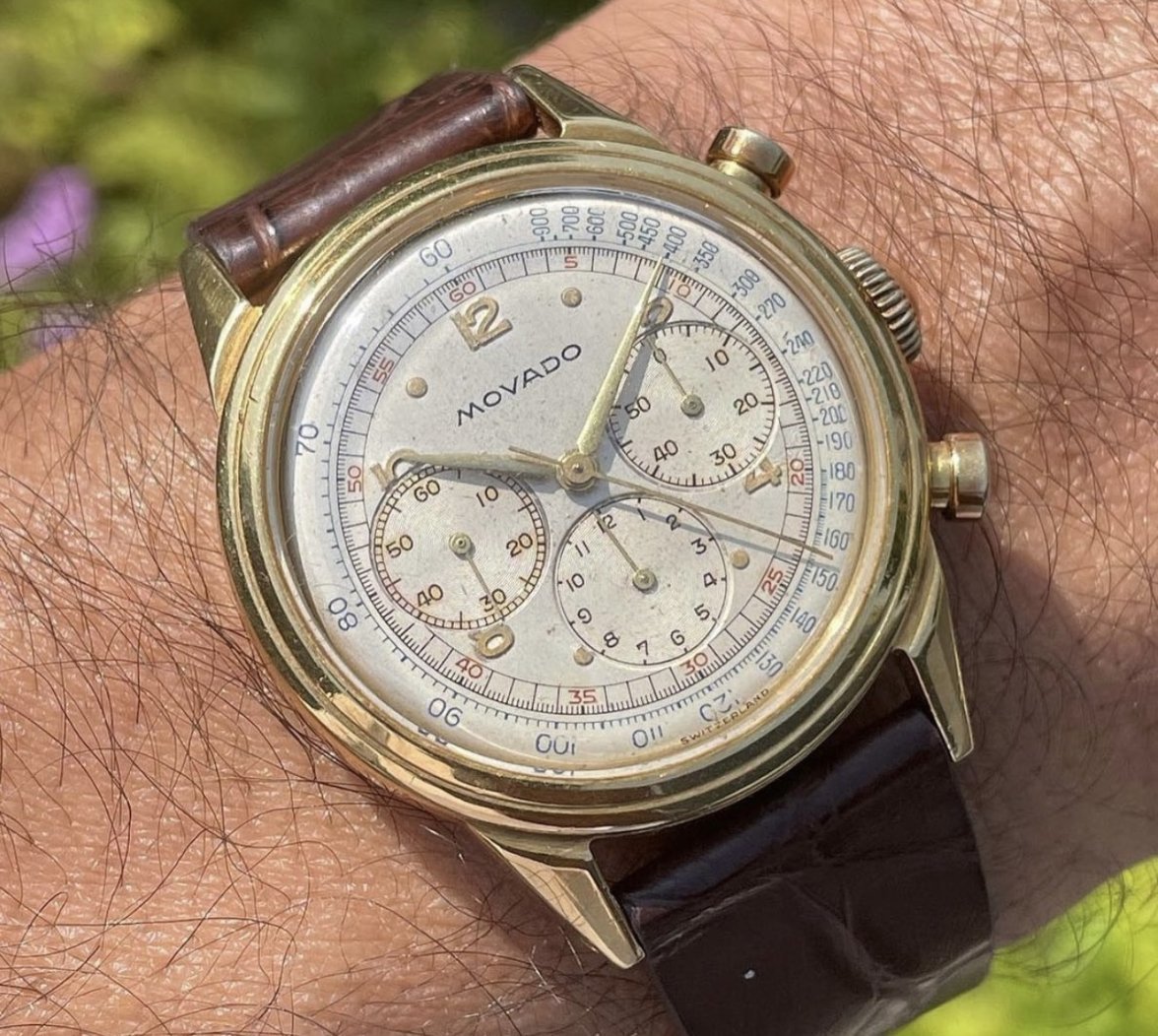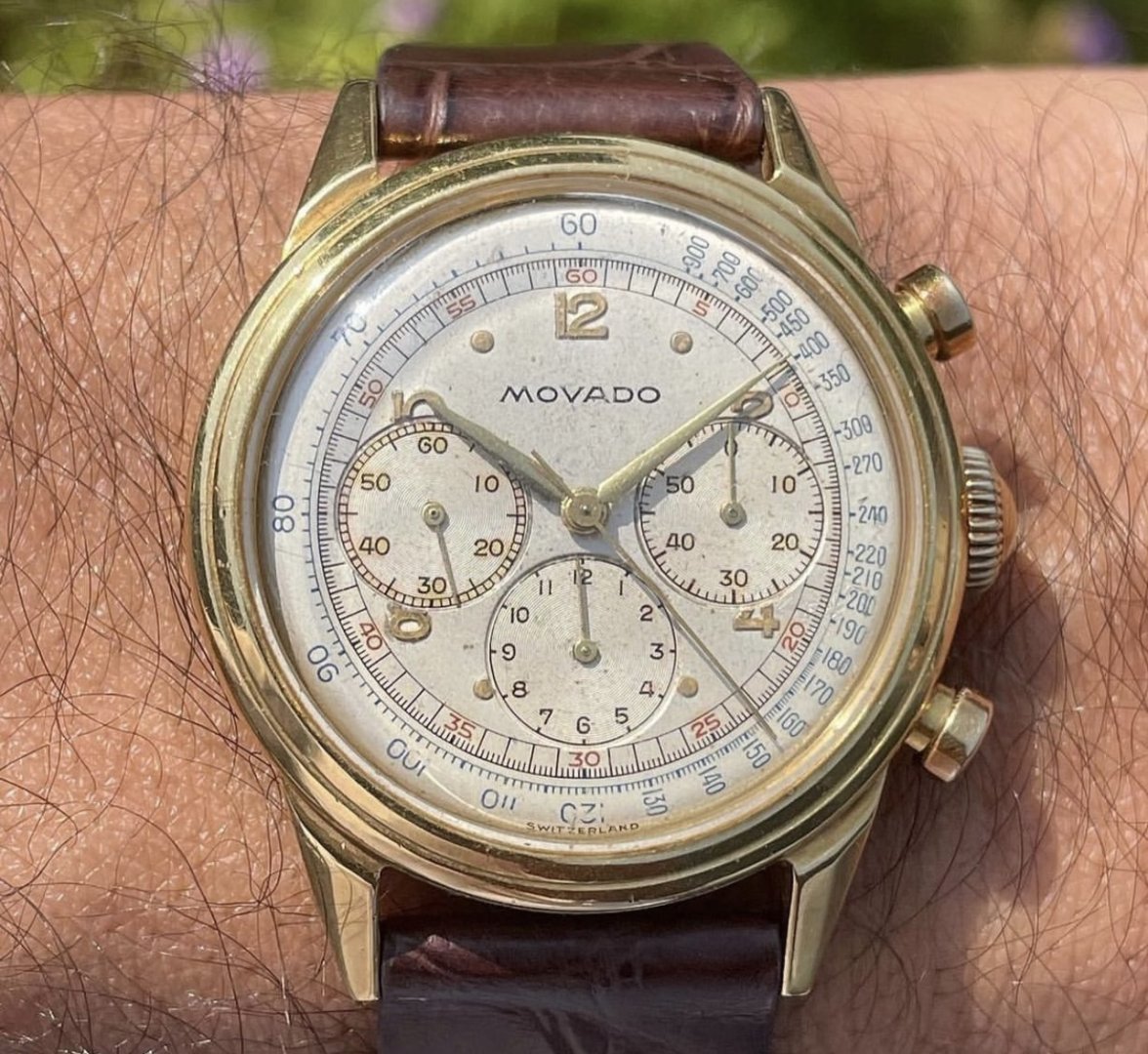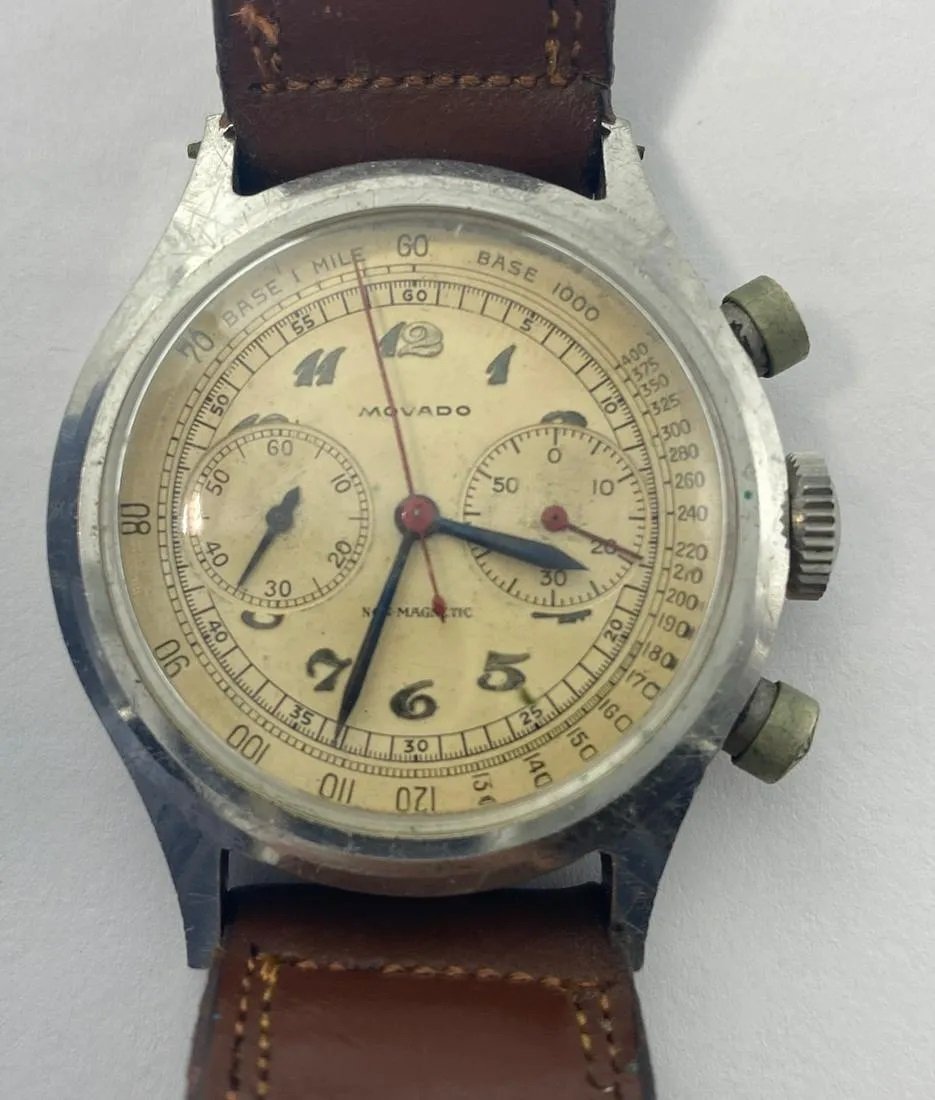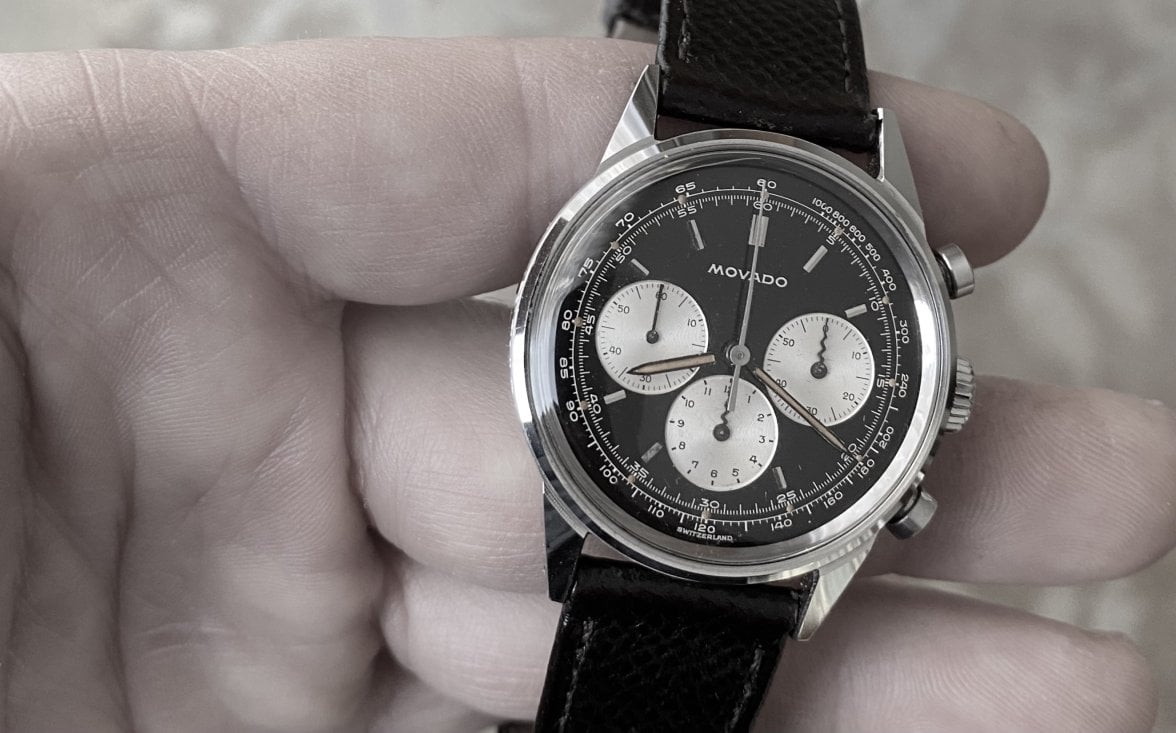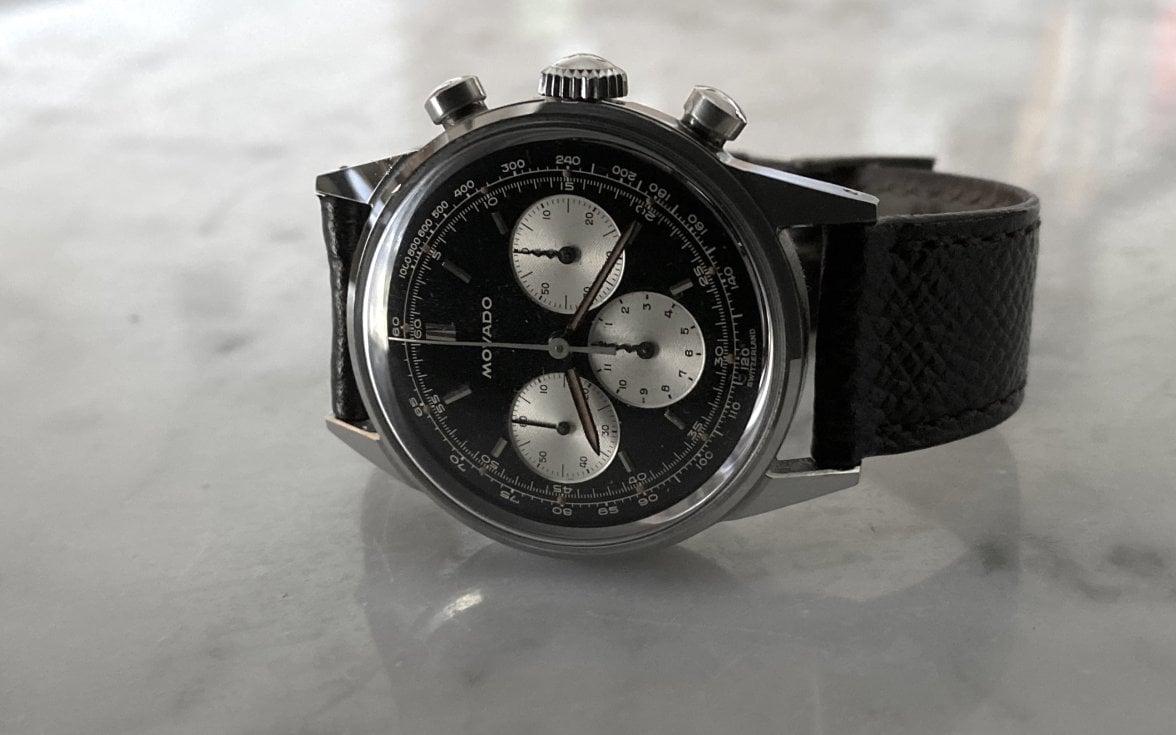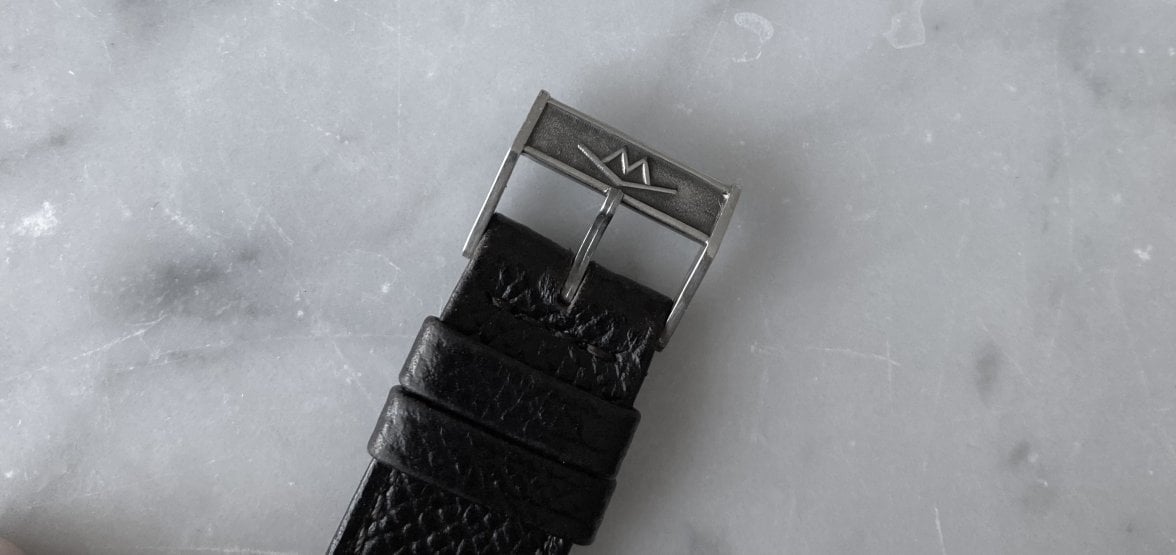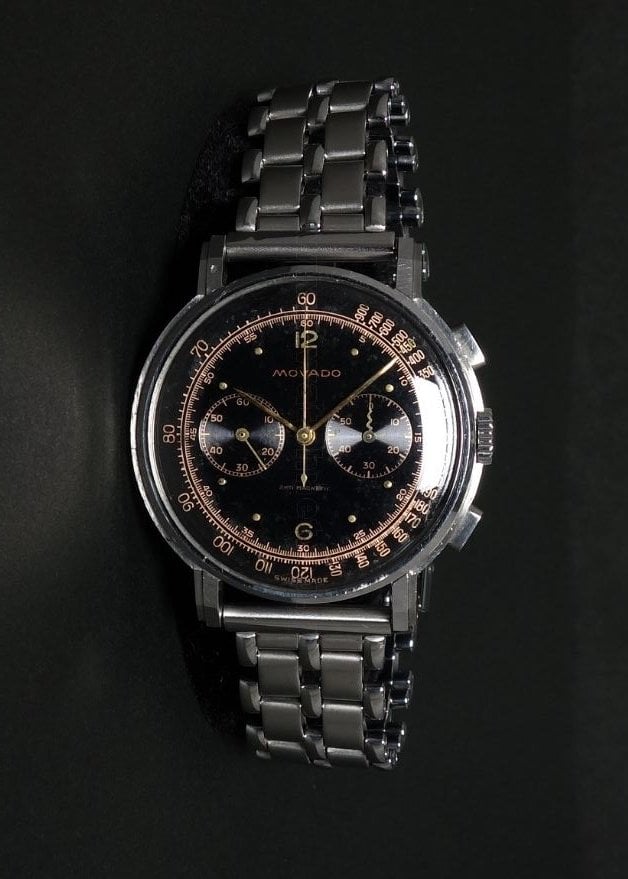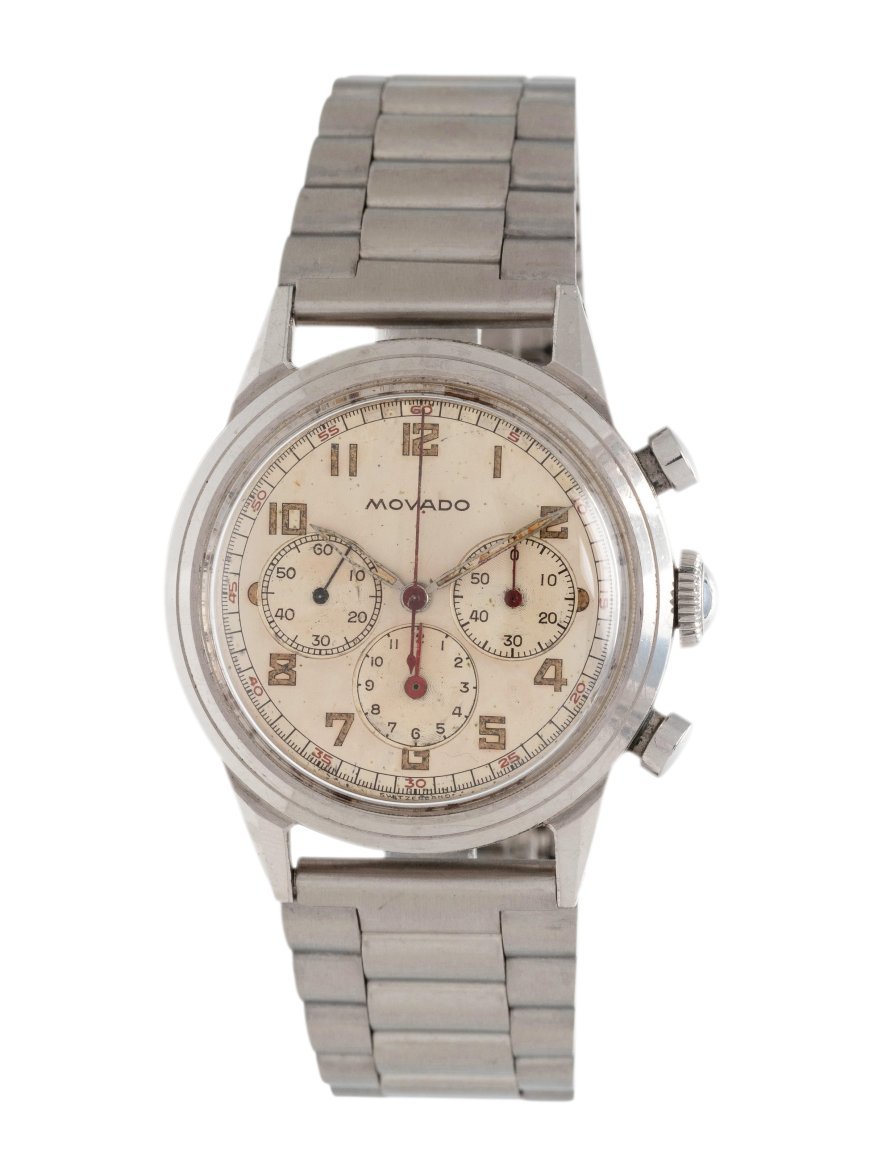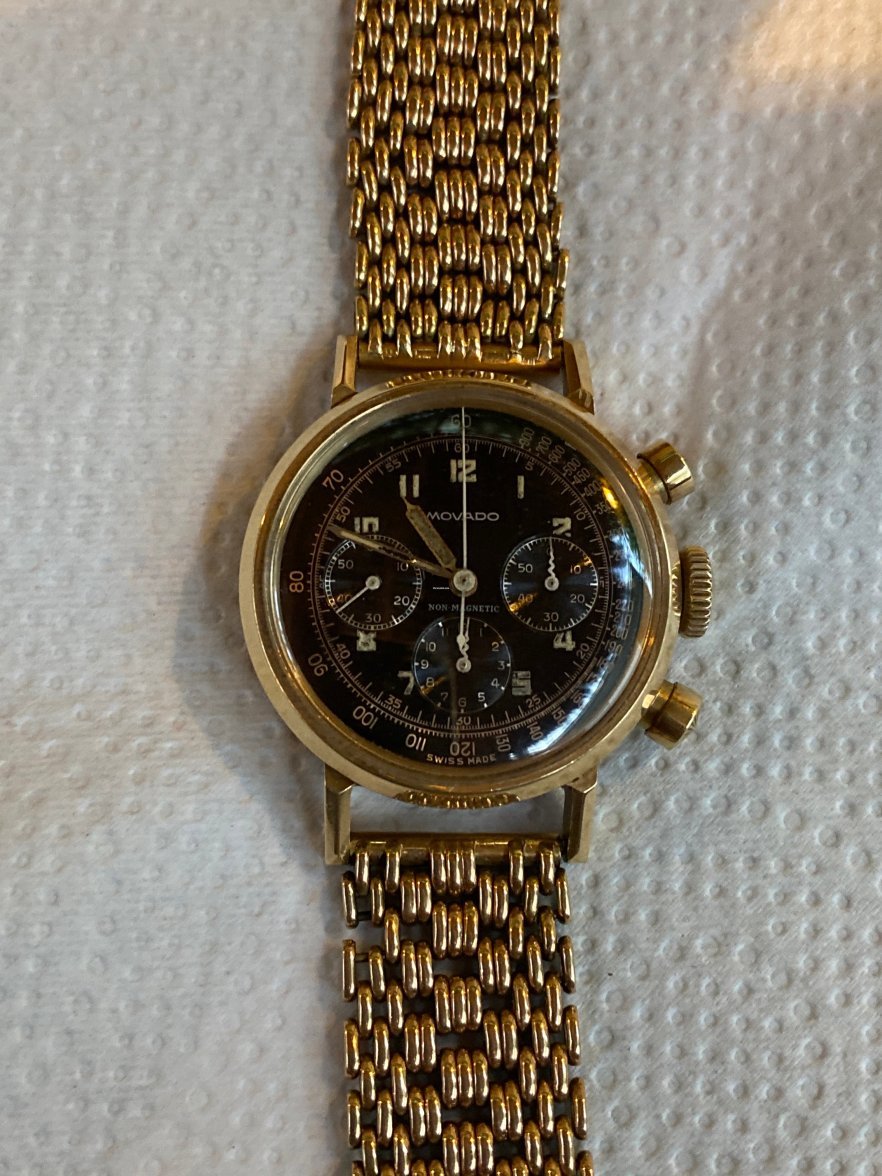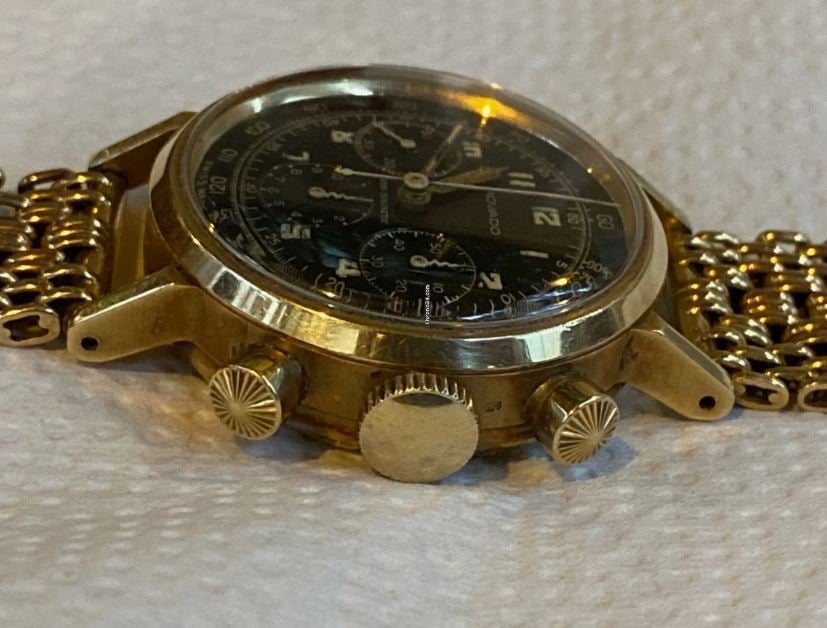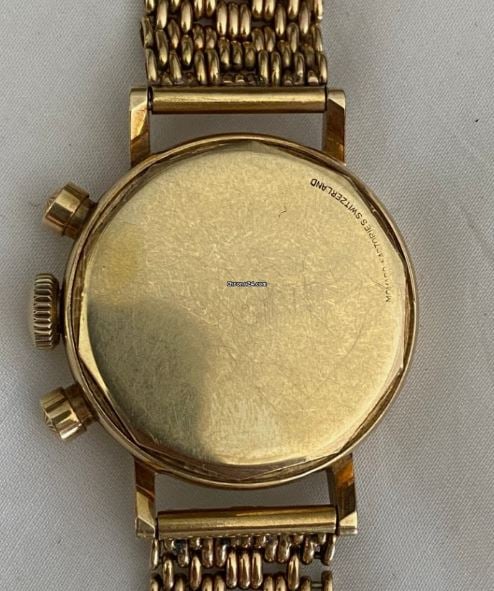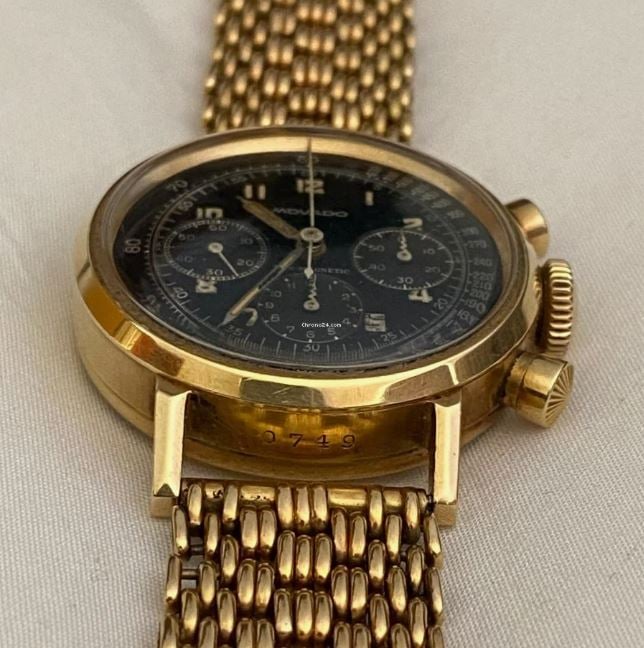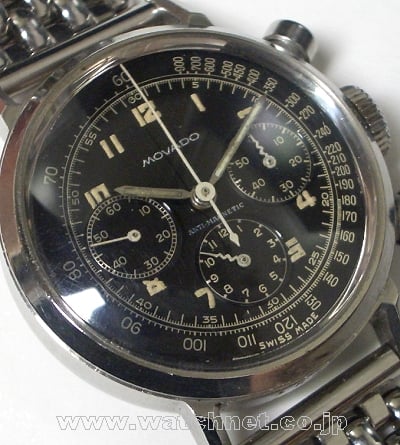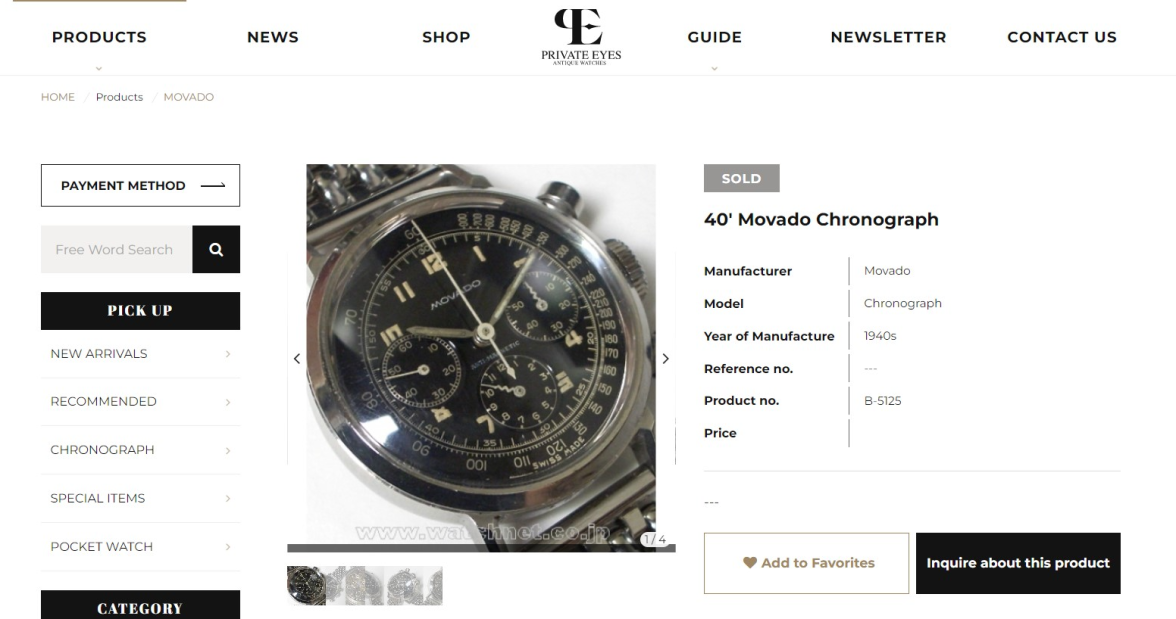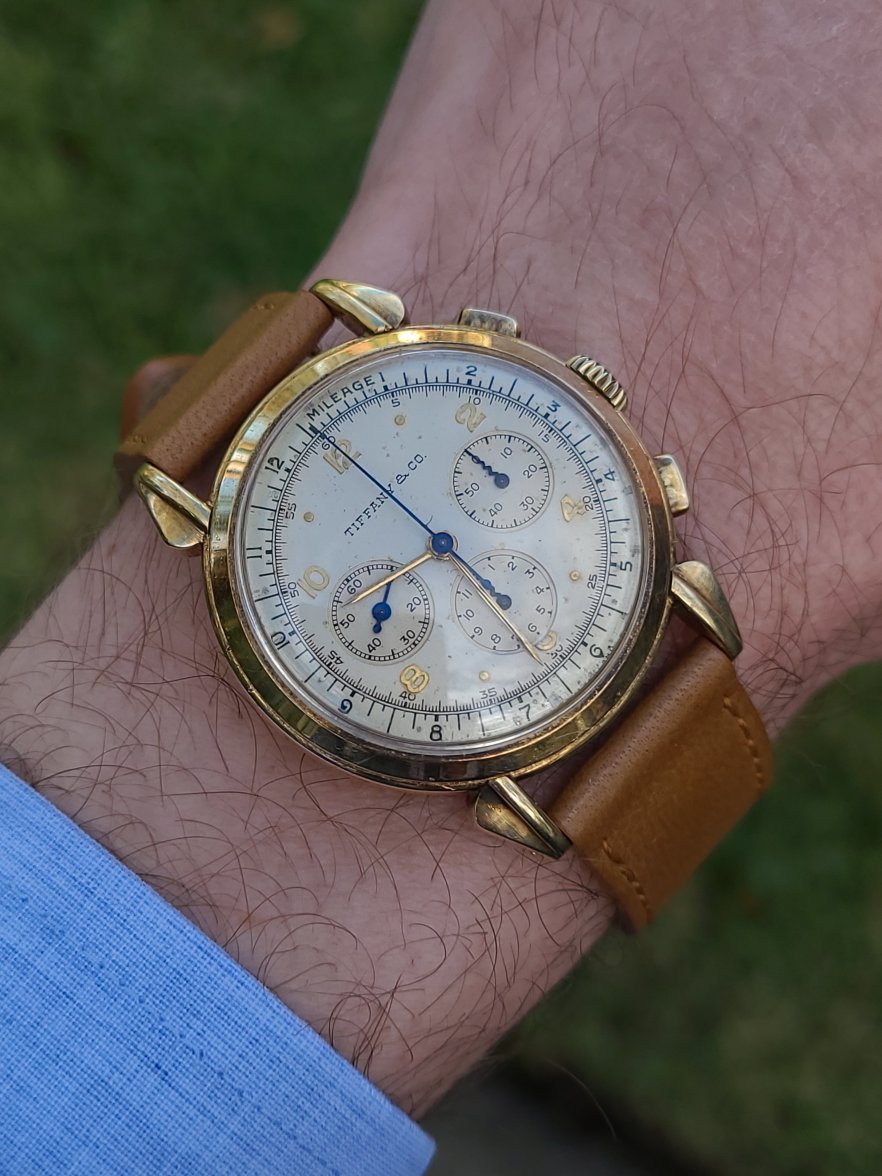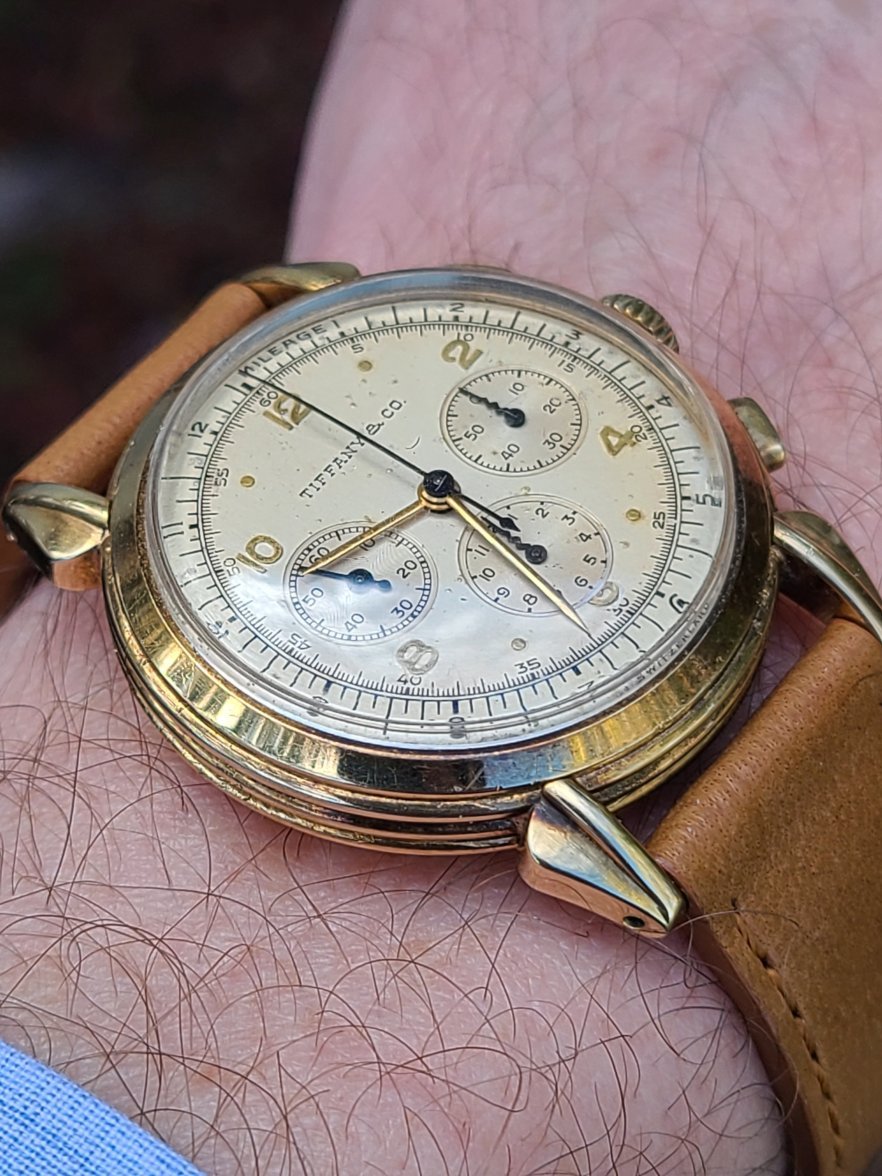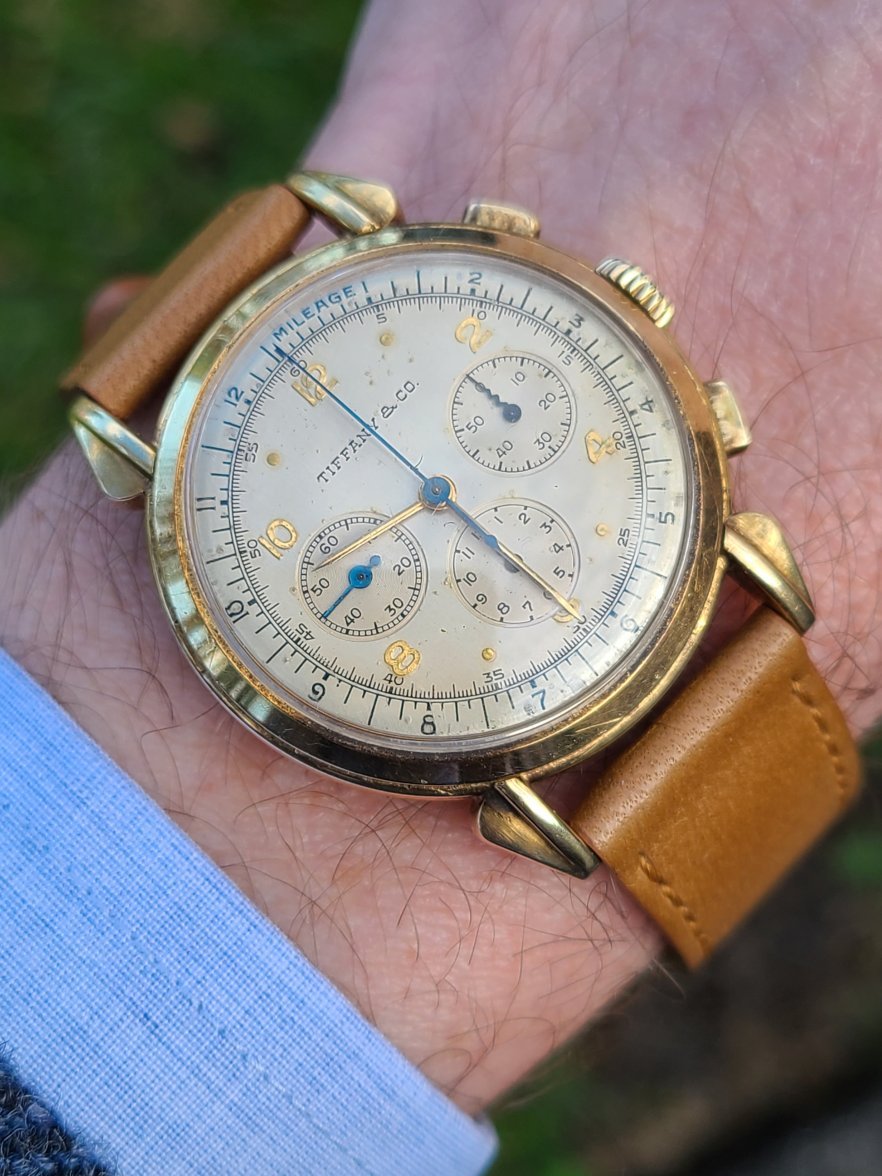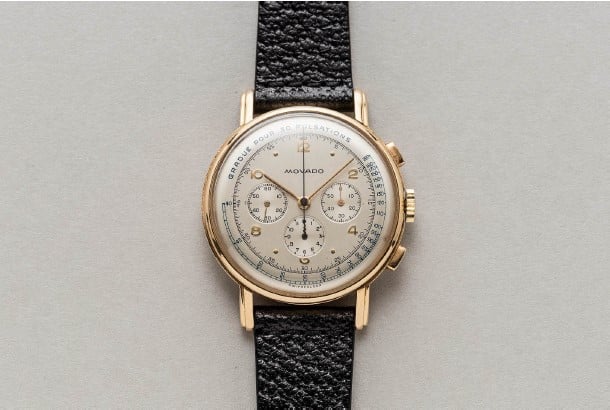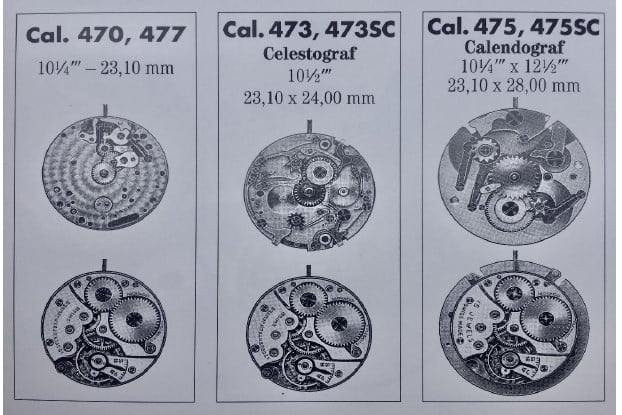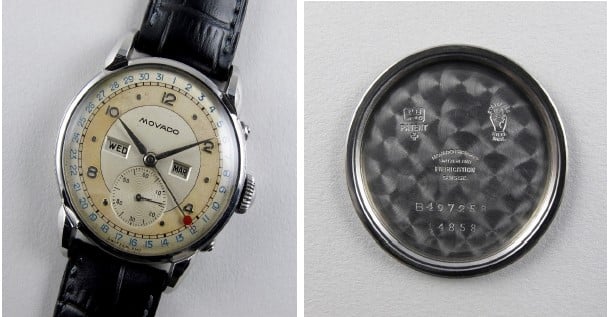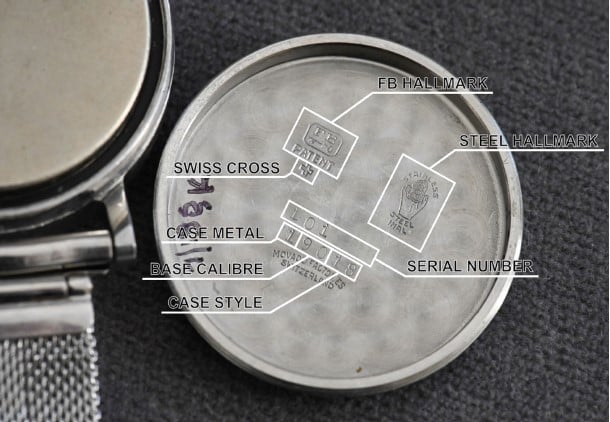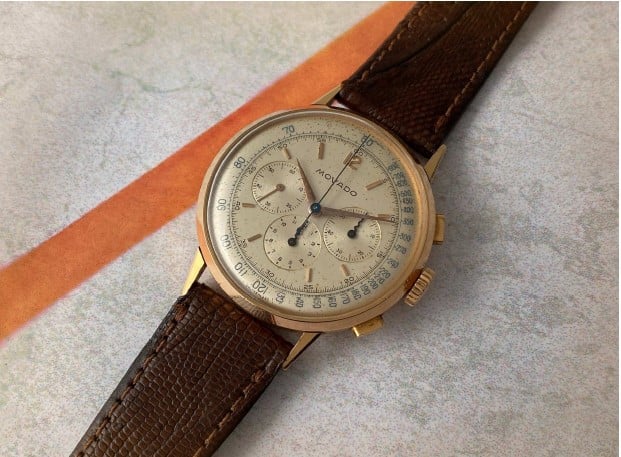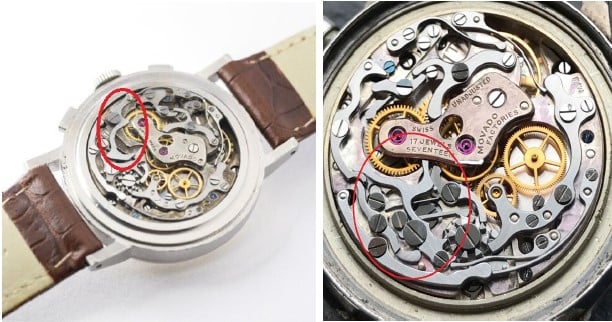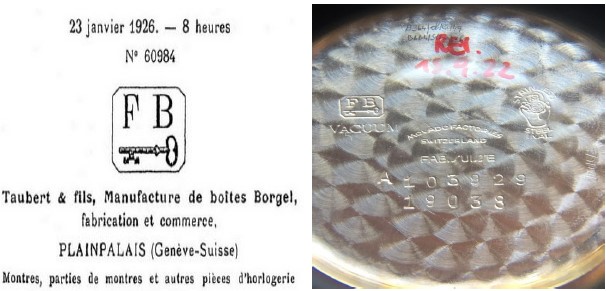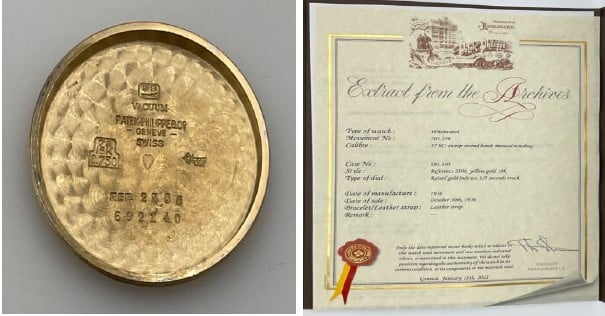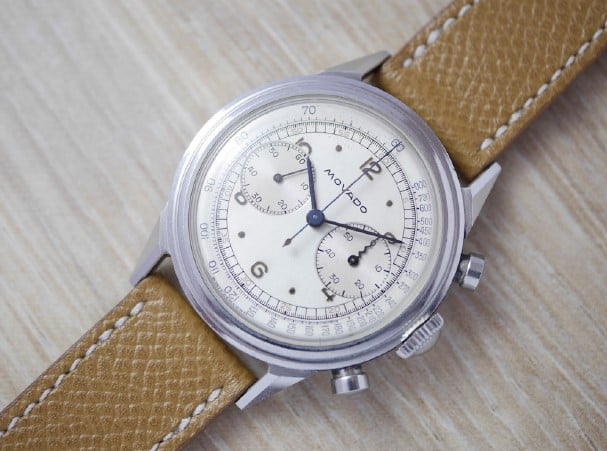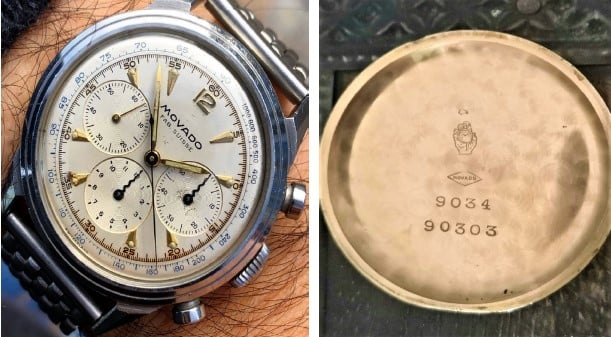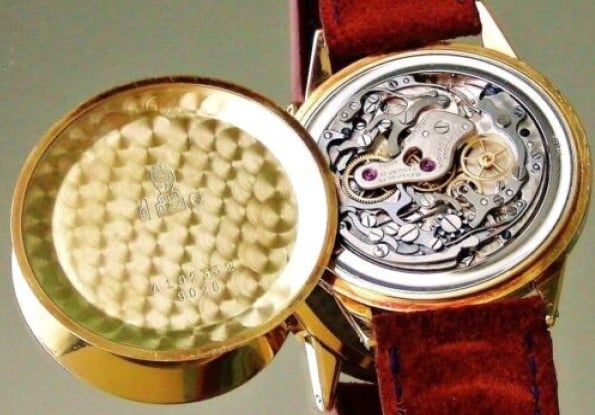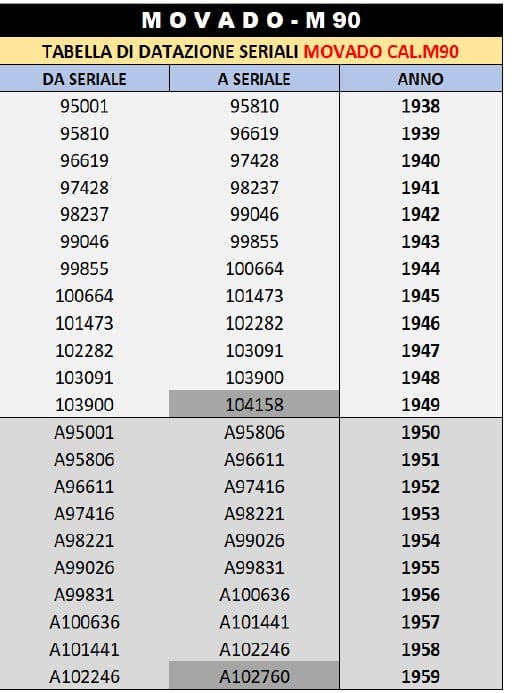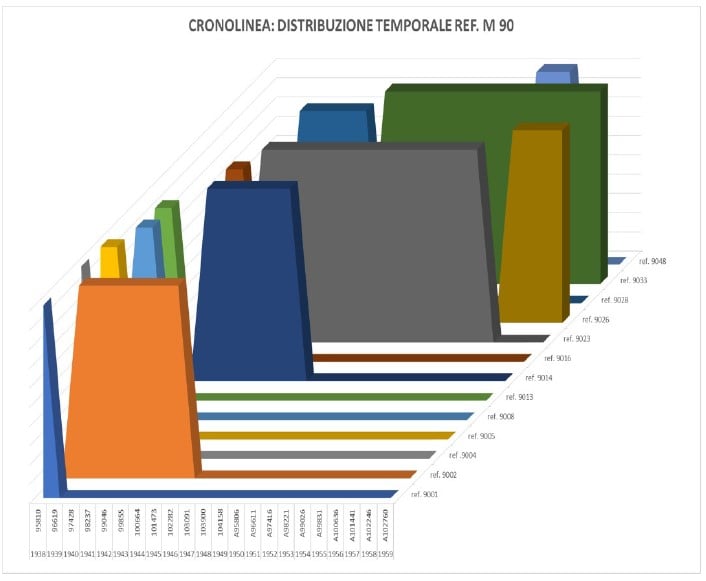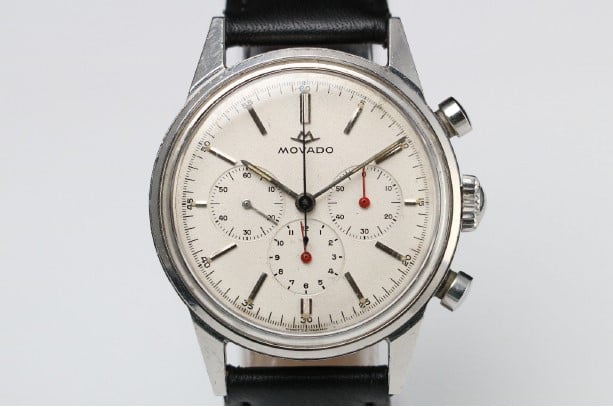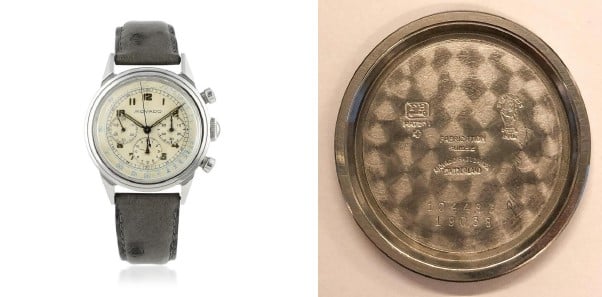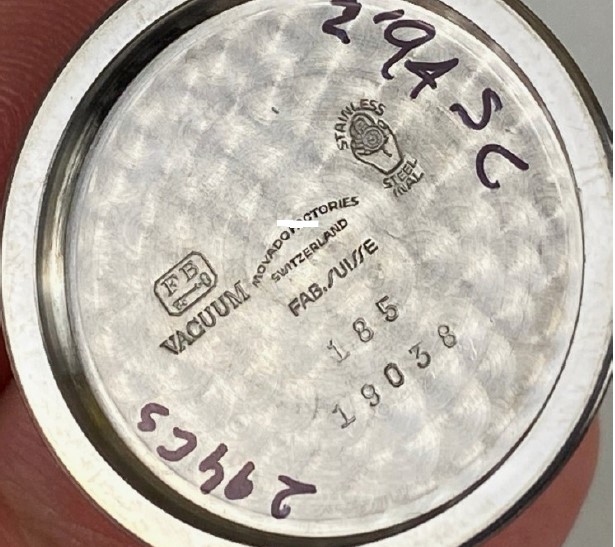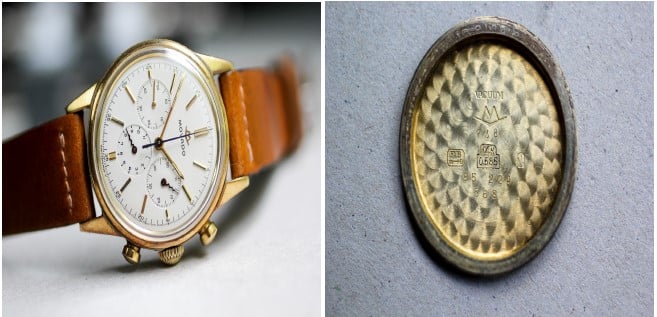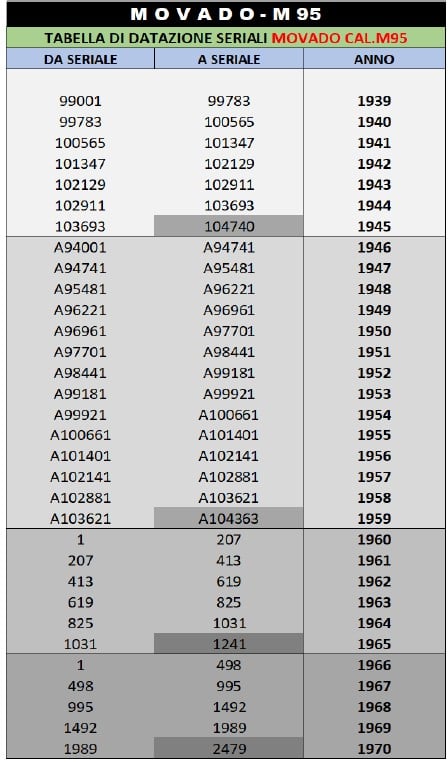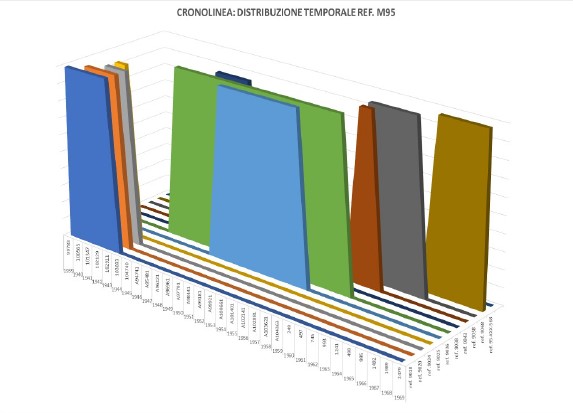Movado M90/95 Thread
Mark020
··not the sharpest pencil in the ΩF drawerNice breguet sold for USD 10.000 excl 23%: https://www.liveauctioneers.com/item/135983241_vintage-stainless-movado-chronograph-wrist-watch
Edited:
Rman
·Mark020
··not the sharpest pencil in the ΩF drawerMark020
··not the sharpest pencil in the ΩF drawerThis 19038 was kind of a bargain at USD 1200 + 29%: https://www.invaluable.com/auction-lot/movado-vintage-stainless-steel-chronograph-wristw-cab49bc802
Edited:
Mark020
··not the sharpest pencil in the ΩF drawerThis is a interesting one (and a bit pricey ;-)): https://www.chrono24.com/movado/chronograph--id25847154.htm
I'm not fully convinced of the dial to be honest (but can't really fault it as well)
I'm not fully convinced of the dial to be honest (but can't really fault it as well)
Mark020
··not the sharpest pencil in the ΩF drawerOn second thought, after having looked in my dial register, I think dial is legit. If the reference is what I think it is it is a very rare reference (I only have 1 other on file)
Edited:
byunjoe
·Yeah the dial looks good to me too, but as you mentioned - that price... ouch
Mark020
··not the sharpest pencil in the ΩF drawer10k is already ambitious for a private seller from Chili
Edited:
Mark020
··not the sharpest pencil in the ΩF drawerMark020
··not the sharpest pencil in the ΩF drawer
This website may earn commission from Ebay sales.
Mark020
··not the sharpest pencil in the ΩF drawerVery nice piece
Mark020
··not the sharpest pencil in the ΩF drawerWonderful piece of research. Originally published here: https://orologi.forumfree.it/?t=79454310. Translation by me.
MOVADO - M 90 AND M 95 SERIAL DATING SYSTEM
(Movado M 95, ref.R9043, serial A97055)
PREMISE: This study has the ultimate goal of dating the M 90 and M 95, nothing else. Ergo, if you are not interested in the preliminary research process, bypass this endless forest of lines and pay attention only to the tables listed at the end.
I want to say again that it was a long and difficult job. A total immersion in a sea made of constantly updated numbers. I have sifted through over 600 serials between M 90 and M 95, and I care about this intention to dutifully mention my friend markk020 - passionate collector - whom I thank here for the availability for almost daily discussions, had half a PM on O&P and again for the generous sharing of the its database of over 400 serials between M 90 and M 95.
Review of the final tables has been ongoing over the past 3 months since the initiation of this study. In certain moments, especially at the beginning, it was disheartening because I didn't arrive at anything concrete but once I found it key was how to be taken by the big picture effect, which is common to Astronauts and Cosmonauts once seen Mother Earth from Space.
All that said, let's get started.
PRELIMINARY ANALYSIS OF THE MOVADO 470 TIME-ONLY CALIBER: THEORY OF THE CHRONOLOGICAL SEQUENCE OF FIRST NUMERICAL AND THEN ALPHANUMERIC SERIAL
(Extrapolation from The Movado History by Fritz von Osterhausen: caliber 470 and derivatives)
Overall view, I said. In fact, if I hadn't started from the parallel study of the Movado serials of the Calendograf and of the Celestograf I would hardly have returned this study complete with satisfactory results. Indeed, while I continued to analyze and catalog the M 90 and M 95 in a database of about two hundred serial orders, I found myself interested in the seriality of the Movado 470 time-only calibers and derivatives 473 and 475, finding a fundamental constant: the serial numbers of the specimens examined (about a hundred) yes configured in single batches made up of numeric and alphanumeric sub-serials, which returned a clear consequentiality between the numerical serials only and following which came the alphanumeric ones; all stacked in an evident progressive chronological relationship.
The 470 caliber in particular - time-only basis for the production of modular/semi-integrated chronograph movements M 90 and M 95 - presents a subdivision of serials which refer to an initial root as follows:
“0047XXXX”, “047XXXX”, “47XXXX”. All of this is clearly inspired by a temporal consequentiality all the more evident that the serial numbers follow, this time alphanumeric: “A47XXXX”, “A48XXXX”, “A49XXXX”. Note how from the initial idea of providing the serials with the numerical ending of the mounted caliber (source The Movado History, by Fritz von Osterhausen, pag.194), we pass for some technical and/or practical reason to keep only the "4" in the case of the cal.470 (and no longer the "47", i.e. the first two identification numbers, in fact, of the movement) and then passing from “A47XXXX to “A48XXXX and then to “A49XXXX”.
Nonetheless there is another incredible amount of sequential alphanumeric lots that follow temporally the previous ones: ”B47XXXX”, “B48XXXX”, “B49XXXX”. And again: “C47XXXX”, “C48XXXX”, “C49XXXX” to then pass again to serials with the ending “D”.
(Movado Calendograf cal 475 in “FB” case, ref. 14858, serial B497258)
This picture is quite significant of the enormous amount of production of the 470, which was the caliber - together with the 150 MN and 125 - among the longest-lived manufactured and cashed by the maison in an innumerable series of references including the other among the luckiest and most distributed, just give time to the complicated.
The lots follow one another from 9'999 pieces to 9'999 pieces: therefore, for example, “00470001”, “00470002”, “00470003” etc up to "00479999" and on subsequent passage to the lot with root "047"; then, again, “0470001”, “0470002” etc.
The same applies to the subsequent alphanumeric serials, for example: from "A470001" to "A479999" to follow the passage to the following batch, "A480001" up to "A489999" and so on.
I have encountered this type of practice linked to the production of serials in various series/models of Movado and for different calibres. I recorded how each model/caliber had its own, individual, unique, serial system. Therefore, starting from the basic concept observed for the production of the cal. 470 in number batches and then sequential alphanumerics (which, as mentioned, I am still analyzing), I approached the analysis of the M 90 and the M 95 that I already had on file. The idea, to my surprise, worked. However, I needed other themes and/or data which, welded together, would solidify this thesis and validate the dating system I proposed in this one study for the M 90 and the M 95.
I found them and I bring them back.
1) INCREASING ORDER OF THE REFERENCE NUMBERS M 90 AND M 95
An element that rests on the thesis of the chronological sequence first of the only numerical serials and then of those divided into parcels is the one relating to the structure of the individual references of the Movado two and three chronographs counters.
The references on the M 90 and on the M 95 are and remain 4 digits until 1966, when from 4 numbers (“XXXX”) the reference will assume a conformation of 8 fractional numbers (“XX”-”XXX”-”XXX”; e.g. from ref. 9068 it will pass to ref. 95 - 214 - 568). We will see this last configuration of the references for the late production of the M 95 in the queue to this writing, but I will start here preliminarily with an examination of the 4-digit references, which for the M 90 identify models manufactured starting from 1938 and for the M95 from the following year (source The Movado History).
As you may know, Movado used to identify a specific model with a 4-number reference (“XXXX”). For the M 90 and the M 95 the first pair of digits is always "90" (therefore "90XX"). Such 4 numbers could be anticipated either by another number or by a letter identifying the construction material of the case.
The references with 18 ct yellow gold cases are an "exception", which maintain only the 4-digit structure ("90XX").
More commonly, both for the M 90 and for the M 95, we will therefore find:
90XX - 18k yellow gold
190XX - where “1” stands for steel
490XX - where “4” stands for 14 ct gold
990XX - where “9” stands for 9 ct gold
R90XX - where “R” stands for 18 ct rose gold
The second pair of numbers (here "XX") is variable: some claim it refers to the shape of the case; others argue that the third number of the reference identifies the shape of the case and the fourth and last number that of the dial configuration.
(Extract from Sjx Watch)
MOVADO - M 90 AND M 95 SERIAL DATING SYSTEM
(Movado M 95, ref.R9043, serial A97055)
PREMISE: This study has the ultimate goal of dating the M 90 and M 95, nothing else. Ergo, if you are not interested in the preliminary research process, bypass this endless forest of lines and pay attention only to the tables listed at the end.
I want to say again that it was a long and difficult job. A total immersion in a sea made of constantly updated numbers. I have sifted through over 600 serials between M 90 and M 95, and I care about this intention to dutifully mention my friend markk020 - passionate collector - whom I thank here for the availability for almost daily discussions, had half a PM on O&P and again for the generous sharing of the its database of over 400 serials between M 90 and M 95.
Review of the final tables has been ongoing over the past 3 months since the initiation of this study. In certain moments, especially at the beginning, it was disheartening because I didn't arrive at anything concrete but once I found it key was how to be taken by the big picture effect, which is common to Astronauts and Cosmonauts once seen Mother Earth from Space.
All that said, let's get started.
PRELIMINARY ANALYSIS OF THE MOVADO 470 TIME-ONLY CALIBER: THEORY OF THE CHRONOLOGICAL SEQUENCE OF FIRST NUMERICAL AND THEN ALPHANUMERIC SERIAL
(Extrapolation from The Movado History by Fritz von Osterhausen: caliber 470 and derivatives)
Overall view, I said. In fact, if I hadn't started from the parallel study of the Movado serials of the Calendograf and of the Celestograf I would hardly have returned this study complete with satisfactory results. Indeed, while I continued to analyze and catalog the M 90 and M 95 in a database of about two hundred serial orders, I found myself interested in the seriality of the Movado 470 time-only calibers and derivatives 473 and 475, finding a fundamental constant: the serial numbers of the specimens examined (about a hundred) yes configured in single batches made up of numeric and alphanumeric sub-serials, which returned a clear consequentiality between the numerical serials only and following which came the alphanumeric ones; all stacked in an evident progressive chronological relationship.
The 470 caliber in particular - time-only basis for the production of modular/semi-integrated chronograph movements M 90 and M 95 - presents a subdivision of serials which refer to an initial root as follows:
“0047XXXX”, “047XXXX”, “47XXXX”. All of this is clearly inspired by a temporal consequentiality all the more evident that the serial numbers follow, this time alphanumeric: “A47XXXX”, “A48XXXX”, “A49XXXX”. Note how from the initial idea of providing the serials with the numerical ending of the mounted caliber (source The Movado History, by Fritz von Osterhausen, pag.194), we pass for some technical and/or practical reason to keep only the "4" in the case of the cal.470 (and no longer the "47", i.e. the first two identification numbers, in fact, of the movement) and then passing from “A47XXXX to “A48XXXX and then to “A49XXXX”.
Nonetheless there is another incredible amount of sequential alphanumeric lots that follow temporally the previous ones: ”B47XXXX”, “B48XXXX”, “B49XXXX”. And again: “C47XXXX”, “C48XXXX”, “C49XXXX” to then pass again to serials with the ending “D”.
(Movado Calendograf cal 475 in “FB” case, ref. 14858, serial B497258)
This picture is quite significant of the enormous amount of production of the 470, which was the caliber - together with the 150 MN and 125 - among the longest-lived manufactured and cashed by the maison in an innumerable series of references including the other among the luckiest and most distributed, just give time to the complicated.
The lots follow one another from 9'999 pieces to 9'999 pieces: therefore, for example, “00470001”, “00470002”, “00470003” etc up to "00479999" and on subsequent passage to the lot with root "047"; then, again, “0470001”, “0470002” etc.
The same applies to the subsequent alphanumeric serials, for example: from "A470001" to "A479999" to follow the passage to the following batch, "A480001" up to "A489999" and so on.
I have encountered this type of practice linked to the production of serials in various series/models of Movado and for different calibres. I recorded how each model/caliber had its own, individual, unique, serial system. Therefore, starting from the basic concept observed for the production of the cal. 470 in number batches and then sequential alphanumerics (which, as mentioned, I am still analyzing), I approached the analysis of the M 90 and the M 95 that I already had on file. The idea, to my surprise, worked. However, I needed other themes and/or data which, welded together, would solidify this thesis and validate the dating system I proposed in this one study for the M 90 and the M 95.
I found them and I bring them back.
1) INCREASING ORDER OF THE REFERENCE NUMBERS M 90 AND M 95
An element that rests on the thesis of the chronological sequence first of the only numerical serials and then of those divided into parcels is the one relating to the structure of the individual references of the Movado two and three chronographs counters.
The references on the M 90 and on the M 95 are and remain 4 digits until 1966, when from 4 numbers (“XXXX”) the reference will assume a conformation of 8 fractional numbers (“XX”-”XXX”-”XXX”; e.g. from ref. 9068 it will pass to ref. 95 - 214 - 568). We will see this last configuration of the references for the late production of the M 95 in the queue to this writing, but I will start here preliminarily with an examination of the 4-digit references, which for the M 90 identify models manufactured starting from 1938 and for the M95 from the following year (source The Movado History).
As you may know, Movado used to identify a specific model with a 4-number reference (“XXXX”). For the M 90 and the M 95 the first pair of digits is always "90" (therefore "90XX"). Such 4 numbers could be anticipated either by another number or by a letter identifying the construction material of the case.
The references with 18 ct yellow gold cases are an "exception", which maintain only the 4-digit structure ("90XX").
More commonly, both for the M 90 and for the M 95, we will therefore find:
90XX - 18k yellow gold
190XX - where “1” stands for steel
490XX - where “4” stands for 14 ct gold
990XX - where “9” stands for 9 ct gold
R90XX - where “R” stands for 18 ct rose gold
The second pair of numbers (here "XX") is variable: some claim it refers to the shape of the case; others argue that the third number of the reference identifies the shape of the case and the fourth and last number that of the dial configuration.
(Extract from Sjx Watch)
Mark020
··not the sharpest pencil in the ΩF drawerLooking at the first hypothesis alone (I didn't even consider the second is plausible), the cases will assume various shapes with marked characterizations especially on the lugs and with decisive design changes in the cases of the models with “FB” case (I won't dwell on this subject but refer to the beautiful piece taken from the blog Sjx Watch of the precious tswiss-t on forums and social networks, whom I thank here for his studies on the subject: https://watchesbysjx.com/2021/03/movado-chronograph-vintage-study.html). Technical and aesthetic evolution in the construction of the cases, however, it has a non-central or in any case secondary role here, since - and it is one conclusive observation - an idea of numerical progression of the final binary pair is observed of the reference numbers. This progression certainly has a correct justification from the variable of the form of the case, but takes on full meaning in the context of a contingent numerical progression over time of the references.
So, for example, for the M 90 the ref. 9005 had to and must come before the ref. 9048 in this pattern; for the M 95, again to give an example, the ref. 9018 had and must come before the ref. 9038. And indeed it is so for certain. Ergo, again to stay with the last example, the ref. 9018 had and must have earlier serials, while the ref. 9038 was and must have serials later. In the scheme of the serials proposed here this adjacency is overwhelming.
Indeed, this framework of "progression of the reference number = chronological progression" finds its own exact location in the dating proposal which is the purpose of this paper. Seriality doesn't lie.
Pay attention to some points now.
In many cases, both for the M 90 and for the M 95, the production of two or more different references is parallel over time and it is justified - this time yes - with the need to co-market different products, therefore, first of all, to give the market different case shapes and sizes at the same time. In other cases a reference numerically earlier (therefore with a lower reference number) exceeds a reference with more recent numbering (therefore with a higher reference number). Here is the law of the market that comes into play: if a model works, sells, and another just launched works less, does not sell, the project is pursued successful remaining on the previous model and stopped the production of the most recent model poorly performing on the market.
(Movado M 90, ref. 19005, serial ?)
That said, for a fully functional scheme I should assume that for the M 90 the ref. 9001 either the oldest - therefore dating back to 1938 - and among the most recent I should find the ref. 9033 and the ref. 9048. The sequence chronologically one of the most statistically significant references in my M 90 database is therefore this:
9001 > 9002 > 9004 > 9005 > 9008 > 9013 > 9014 > 9016 > 9023 > 9026 > 9028 > 9033 > 9048
[*A few exceptions are the ref. 9026, which compared to the ref. 9028 has later serials and all very close together. I believe that this depends on the meager number of collected serial codes of the ref. 9026, precisely (only 12)]
In the same way, among the M 95s, I should see the ref. 9015 and the ref. 9018, and among the most recent ref. 9058 before and the ref. 9068 below. The chronological sequence among the references more statistically of my database of M 95 is therefore this:
9018 > 9020 > 9024 > 9036 > 9038 > 9043 > 9046 > 9056 > 9058 > 9068
And again: to endorse this hypothesis as correct, I would have to find contiguous (or in any case not very distant) in the same chronological span the parallel references of M 90 and M 95 . So, for example, the references 9001 >9002 > 9004 > 9005 > 9008 > 9013 > 9014 of the M90 cannot and must not be distant in time from references 9018 > 9020 > 9024 > 9036 > 9038 of the M 95 (although - please note - the production of the M95 began a year after that of the M 90).
In this sense, pay attention once again to what was said above about the progress of good models/references successful on the market and whose production was extended over time (for the M 90 the refs. 9002, 9014, 90 23 and 90 33; for the M 95 the ref. 9036, 9038 and 9068) and the parallel arrest of models/references of lower commercial success and whose production was limited or very limited over time (for the M 90 the ref. 9004, 9014, 9016, 9026; for the M 95 the ref. 9024, 9043, 9058).
(Movado M 95 ref. R9046, serial A103679)
Among the M 95s, the ref. 9038 - by far the most produced reference for three-counter chronographs - is temporally contiguous to many different references of M 90 together, in particular it overlaps with the parallel production of the refs. 9014, 9023, 9026, 9028, 9033, 9048.
In conclusion: this sequential scheme of numerically progressive references over time finds perfect fit with the serial dating system proposed in this study. The adjacencies are exact and perfect.
2) TECHNICAL DEVELOPMENT OF THE CALIBER: EVOLUTION OF THE SHAPE OF THE RESETTING HAMMER
To the equation “progression of the reference number = chronological progression” we can add a third element: “progression of the reference number + technical development of the caliber = progression chronological".
Technical development enters the field, in particular that detectable in the transition from the "ice ax" shape to the “Italia” shape of the resetting hammer.
Although in a non-technical way here, the structural change of the M 90 calibers can also be observed over time and M 95, especially in the shape of the zeroing scale, which originally, in the first series calibers recessed both on the two and on the three registers, it had a shape that I would define as an "ice ax" (just like the one in use in mountaineering). This technical peculiarity is typical of the first references.
Also in this case, the first references that mounted this movement with this primitive characteristic, they must have had earlier serials; while those references transitioned to the "new" caliber with receiver of reset in the shape of "Italy" must have more recent serials. In this study, the tables proposed find - again - exact correspondence with this development.
For the M 90 the resetting hammer in the shape of an “ice ax” is present from the ref 9001 up to the ref. 9033, one of the most long-lived, and which crosses the transition to the definitive form to "Italy" around the serial 104.000. We are exactly at the gap between the numeric and alphanumeric serials, therefore - I anticipate it - between 1948 and 1949.
Among the M 95s this technical modification appears earlier. If in the refs. 9018, 9020 and still in 9024 is present the resetting hammer in the shape of an "ice ax", from the ref. 9038 introduced in 1946, the switch to the shaped one of Italy". We are also here around the serial 104.000, just like for the M 90.
The fact that the M 90s have kept their original caliber longer than the M 95s, I think, depends on the need of the maison to continue to use the components already produced, and, registered the fast success with the introduction of the three-register chronograph with the highly successful ref. 9038, which needed all the economic-productive efforts of the house, the transition on the M 90 was softer until the definitive conversion occurred 3 years later than the M 95.
(Movado M 95, ref. 19024, ser. 102026) (Movado M 95, ref. 19038, ser. A96XXX)
3) TRANSITION FROM “PATENT TO “VACUUM” ON BORGEL-TOLBERT CASES
Another piece of evidence that affirmed the validity of the proposal of the time sequence of numerically first serial lots and then alphanumeric I found it in the analysis of the “FB” cases, which Movado - as well as Patek Philippe, Mido, West End Watch & Co - used almost immediately for both its two-register and three-register chronographs (over that for the time only).
The Francois Borgel / Tolbert & Fils cases (whose technical characteristics and patents I will not discuss here) have the peculiarity of presenting the classic punching of an eight-sided inscribing frame on the inside of the case back the acronym “FB” and under which there is the representation of a stylized key. Outside of this frame, immediately below, the words "PATENT" can be read alternately (accompanied by the hallmark of the Swiss cross) or “VACUUM”.
[*Another typical feature of the “FB” case is that it shows the last 4 digits of the serial punched at 12 o'clock or 6 o'clock between the handles. But that is of little interest here].
(Registration of the trademark “FB” by Taubert & Fils, 1926) (“VACUUM” on the back of an M 95, ref. 19038, serial A103929)
According to the authoritative vintagewatchstraps.com (here: https://www.vintagewatchstraps.com/taubert.php ) these entries had to be sequential over time.
Referring to what was also analyzed by Ranfft, at a certain point around the mid-1950s the wording "VACUUM" replaced the word "PATENT". The reasons/hypotheses for this change are different and here are of no interest for the ultimate purposes of this study. The thing instead of great interest is the mention at an auction of Sotheby's 2007 in which it is presented, verbatim: "A Fine and Rare Patek Philippe Gold Chronograph Wristwatch with Register and Tachometer 1952, Movement No. 868505, Case No. 679108, Ref. 1463J” [...]
“Accompanied by a Patek Philippe Certificate d'Origine et de Garantie stamped Geneva 1961. Further accompanied by a Patek Philippe Extract from the Archives confirming production in 1952 and its subsequent sale on August 10th, 1961”. Alongside is the photographic image of the internal case back with the clear “PATENT” indication. Ergo, at least until 1952 this inscription was in use on the “FB” cases produced by Tolbert & Fils. This important passage follows below, which I quote again verbatim: “Thanks to John in Horsham PA who sent me an image of a Patek Philippe Ref 2508 case back with VACUUM stamped under the FB-key Borgel/Taubert trademark. John thinks this is a mid 1950's watch, which accords with the data from Dr. Ranfft's website. John tells me that he has seen other Patek Philippe Ref 2508 case backs online with the word PATENT in the same place under the FB-key trademark”.
So, for example, for the M 90 the ref. 9005 had to and must come before the ref. 9048 in this pattern; for the M 95, again to give an example, the ref. 9018 had and must come before the ref. 9038. And indeed it is so for certain. Ergo, again to stay with the last example, the ref. 9018 had and must have earlier serials, while the ref. 9038 was and must have serials later. In the scheme of the serials proposed here this adjacency is overwhelming.
Indeed, this framework of "progression of the reference number = chronological progression" finds its own exact location in the dating proposal which is the purpose of this paper. Seriality doesn't lie.
Pay attention to some points now.
In many cases, both for the M 90 and for the M 95, the production of two or more different references is parallel over time and it is justified - this time yes - with the need to co-market different products, therefore, first of all, to give the market different case shapes and sizes at the same time. In other cases a reference numerically earlier (therefore with a lower reference number) exceeds a reference with more recent numbering (therefore with a higher reference number). Here is the law of the market that comes into play: if a model works, sells, and another just launched works less, does not sell, the project is pursued successful remaining on the previous model and stopped the production of the most recent model poorly performing on the market.
(Movado M 90, ref. 19005, serial ?)
That said, for a fully functional scheme I should assume that for the M 90 the ref. 9001 either the oldest - therefore dating back to 1938 - and among the most recent I should find the ref. 9033 and the ref. 9048. The sequence chronologically one of the most statistically significant references in my M 90 database is therefore this:
9001 > 9002 > 9004 > 9005 > 9008 > 9013 > 9014 > 9016 > 9023 > 9026 > 9028 > 9033 > 9048
[*A few exceptions are the ref. 9026, which compared to the ref. 9028 has later serials and all very close together. I believe that this depends on the meager number of collected serial codes of the ref. 9026, precisely (only 12)]
In the same way, among the M 95s, I should see the ref. 9015 and the ref. 9018, and among the most recent ref. 9058 before and the ref. 9068 below. The chronological sequence among the references more statistically of my database of M 95 is therefore this:
9018 > 9020 > 9024 > 9036 > 9038 > 9043 > 9046 > 9056 > 9058 > 9068
And again: to endorse this hypothesis as correct, I would have to find contiguous (or in any case not very distant) in the same chronological span the parallel references of M 90 and M 95 . So, for example, the references 9001 >9002 > 9004 > 9005 > 9008 > 9013 > 9014 of the M90 cannot and must not be distant in time from references 9018 > 9020 > 9024 > 9036 > 9038 of the M 95 (although - please note - the production of the M95 began a year after that of the M 90).
In this sense, pay attention once again to what was said above about the progress of good models/references successful on the market and whose production was extended over time (for the M 90 the refs. 9002, 9014, 90 23 and 90 33; for the M 95 the ref. 9036, 9038 and 9068) and the parallel arrest of models/references of lower commercial success and whose production was limited or very limited over time (for the M 90 the ref. 9004, 9014, 9016, 9026; for the M 95 the ref. 9024, 9043, 9058).
(Movado M 95 ref. R9046, serial A103679)
Among the M 95s, the ref. 9038 - by far the most produced reference for three-counter chronographs - is temporally contiguous to many different references of M 90 together, in particular it overlaps with the parallel production of the refs. 9014, 9023, 9026, 9028, 9033, 9048.
In conclusion: this sequential scheme of numerically progressive references over time finds perfect fit with the serial dating system proposed in this study. The adjacencies are exact and perfect.
2) TECHNICAL DEVELOPMENT OF THE CALIBER: EVOLUTION OF THE SHAPE OF THE RESETTING HAMMER
To the equation “progression of the reference number = chronological progression” we can add a third element: “progression of the reference number + technical development of the caliber = progression chronological".
Technical development enters the field, in particular that detectable in the transition from the "ice ax" shape to the “Italia” shape of the resetting hammer.
Although in a non-technical way here, the structural change of the M 90 calibers can also be observed over time and M 95, especially in the shape of the zeroing scale, which originally, in the first series calibers recessed both on the two and on the three registers, it had a shape that I would define as an "ice ax" (just like the one in use in mountaineering). This technical peculiarity is typical of the first references.
Also in this case, the first references that mounted this movement with this primitive characteristic, they must have had earlier serials; while those references transitioned to the "new" caliber with receiver of reset in the shape of "Italy" must have more recent serials. In this study, the tables proposed find - again - exact correspondence with this development.
For the M 90 the resetting hammer in the shape of an “ice ax” is present from the ref 9001 up to the ref. 9033, one of the most long-lived, and which crosses the transition to the definitive form to "Italy" around the serial 104.000. We are exactly at the gap between the numeric and alphanumeric serials, therefore - I anticipate it - between 1948 and 1949.
Among the M 95s this technical modification appears earlier. If in the refs. 9018, 9020 and still in 9024 is present the resetting hammer in the shape of an "ice ax", from the ref. 9038 introduced in 1946, the switch to the shaped one of Italy". We are also here around the serial 104.000, just like for the M 90.
The fact that the M 90s have kept their original caliber longer than the M 95s, I think, depends on the need of the maison to continue to use the components already produced, and, registered the fast success with the introduction of the three-register chronograph with the highly successful ref. 9038, which needed all the economic-productive efforts of the house, the transition on the M 90 was softer until the definitive conversion occurred 3 years later than the M 95.
(Movado M 95, ref. 19024, ser. 102026) (Movado M 95, ref. 19038, ser. A96XXX)
3) TRANSITION FROM “PATENT TO “VACUUM” ON BORGEL-TOLBERT CASES
Another piece of evidence that affirmed the validity of the proposal of the time sequence of numerically first serial lots and then alphanumeric I found it in the analysis of the “FB” cases, which Movado - as well as Patek Philippe, Mido, West End Watch & Co - used almost immediately for both its two-register and three-register chronographs (over that for the time only).
The Francois Borgel / Tolbert & Fils cases (whose technical characteristics and patents I will not discuss here) have the peculiarity of presenting the classic punching of an eight-sided inscribing frame on the inside of the case back the acronym “FB” and under which there is the representation of a stylized key. Outside of this frame, immediately below, the words "PATENT" can be read alternately (accompanied by the hallmark of the Swiss cross) or “VACUUM”.
[*Another typical feature of the “FB” case is that it shows the last 4 digits of the serial punched at 12 o'clock or 6 o'clock between the handles. But that is of little interest here].
(Registration of the trademark “FB” by Taubert & Fils, 1926) (“VACUUM” on the back of an M 95, ref. 19038, serial A103929)
According to the authoritative vintagewatchstraps.com (here: https://www.vintagewatchstraps.com/taubert.php ) these entries had to be sequential over time.
Referring to what was also analyzed by Ranfft, at a certain point around the mid-1950s the wording "VACUUM" replaced the word "PATENT". The reasons/hypotheses for this change are different and here are of no interest for the ultimate purposes of this study. The thing instead of great interest is the mention at an auction of Sotheby's 2007 in which it is presented, verbatim: "A Fine and Rare Patek Philippe Gold Chronograph Wristwatch with Register and Tachometer 1952, Movement No. 868505, Case No. 679108, Ref. 1463J” [...]
“Accompanied by a Patek Philippe Certificate d'Origine et de Garantie stamped Geneva 1961. Further accompanied by a Patek Philippe Extract from the Archives confirming production in 1952 and its subsequent sale on August 10th, 1961”. Alongside is the photographic image of the internal case back with the clear “PATENT” indication. Ergo, at least until 1952 this inscription was in use on the “FB” cases produced by Tolbert & Fils. This important passage follows below, which I quote again verbatim: “Thanks to John in Horsham PA who sent me an image of a Patek Philippe Ref 2508 case back with VACUUM stamped under the FB-key Borgel/Taubert trademark. John thinks this is a mid 1950's watch, which accords with the data from Dr. Ranfft's website. John tells me that he has seen other Patek Philippe Ref 2508 case backs online with the word PATENT in the same place under the FB-key trademark”.
Mark020
··not the sharpest pencil in the ΩF drawerI therefore had 1952 as a first reference as a date in which the wording "PATENT" was still in use but it was not enough. I needed to find the clear time reference for the transition to "VACUUM", which in the piece of vintagewatchstraps.com remained evidence. I was looking for the exact year.
So I set out on the hunt for a Patek Philippe with an archive extract that would provide me with certain testimony of this transition around the mid-1950s or in any case after 1952. This example (see photo) is a ref. 2508 serial 692.140 accompanied by its archive extract and in which 1956 is reported as the year of production. For the first time, the "VACUUM" stamp is present on the inside of the case back at the top. It proves as claimed by vintagewatchstraps.com but in an exact way, with chronological value, since the specimens still up to 1955 bore the wording "PATENT" (the auction house Auction FR auctioned on 25 October 2015 an example of 2508, lot n°33, dated 1955 from an archive extract and which still had the inscription “PATENT” on the inside case back).
Ergo, the Patek Philippe ref. 2508 at a certain point, between 1956 and 1957, therefore changed from "PATENT" to VACUUM” the internal wording.
I had another valid and still useful boundary line to support my dating of Movado chronographs: up to 1955/1956 I should have found the case backs (and therefore serial numbers) of the M 90 and M 95 in the case "FB" with the inscription “PATENT”; beyond 1956/1957 I should instead have found case backs (and therefore serial numbers) with the wording “VACUUM”.
Good: the dating system proposed here is based on the consequentiality of first numerical serials and then alphanumeric, records an absolute adherence to this step. Approximately between serial A99831 and serial A101441 this transition is observed on the M 90; while for the M 95 this happens between the serial number A102141 and the serial number A102881 (with an error difference in the order of a hundred pieces). In both cases the dating table from me proposal certifies the transition from "PATENT" to "VACUUM" in the year 1956/1957, exactly as for Patek Philippe.
MOVADO M 90: DATING
(Movado M 90, ref. 19048, serial A99XXX)
Let's go back to the starting scheme seen for the caliber 470. For the dating of the M 90 I was looking for something that resembled - as for the Calendographs and Celestographs - the basic structure with the numbers ("X") but reduced by thousands of the huge 470 output, to hundreds for making some outnumbered contained in the chronographs. Something resembling stacking in first numeric and then alphanumeric lots as for cal. 470. Something like below:
0090XXX
090XXX
90XXX
etc...
and then move on at some point to:
A90XXX
A91XXX
A92XXX
A93XXX
etc...
and again, perhaps, to:
B90XXX
B91XXX
B92XXX
etc...
and then, perhaps, to:
C90XXX
C91XXX
C92XXX
etc...
Naturally it would have all been too simple and the Ditesheim brothers, imagining the future well, already they enjoyed thinking about it among a thousand numbers scattered among notebooks, paperwork and pizza’s; between Excel files and pages of Words incomprehensible even to John Nash. They wanted us to be “always on the go” (at least with the intellect).
In fact, there is no M 90 or even M 95 serial starting with “0090” or “090” (except for a couple of cases on over 600 serials examined and which therefore do not make statistics); nor is there any case back bearing a alphanumeric serial starting with “A90”, “B90”, “C90” etc.
However, there is a singularity: my studies have shown that there are serials that actually start with "90", but also for “80”, and which however are part of an exclusive production for the French market. Such specimens have common and easily distinguishable characteristics: double denomination of origin with the wording “Fab.Suisse” little under the wording "Movado" at the top of the dial at 12 o'clock and the wording "Swiss Made" or "Switzerland" always present at 6 o'clock; double logo on the back with the hand holding the pocket watch and another, just below, with a rhombus containing the wording “Movado”; in the rose gold and 14 ct gold specimens. Lacks respectively the "R" and the "4" suffix of the reference number. These features are more typical of the M 90 e of the M 95 in precious metal and I also found them in examples of Calendograf and Celestograf always in gold. The stamp of the eagle's head, which is always present, confirms this all-French destination of these lots with serials starting with “90” and “80”. These exclusive lots for the French market are therefore not part of the "normal" Movado serial production of M 90 and M 95, which is here under examination. Instead they follow the "normal" serial production of the M 90 and M 95 in steel - including those with "FB" cases - bearing however the writing “Fab.Swisse” on the dial. I intend to delve into the case of serials in second place “French” with precious metal cases.
(Movado M 95 “Fab.Swisse” in case “FB”, ref. 19038, ser. A103120) (Movado M 90 “Fab.Swisse”, ref.9034, ser. 90303)
So let's go back to the "normal" M 90.
From the backward analysis of the serials for the Movado two-register chronograph it is crystal clear that there is no any exclusively numerical serial that falls below 95001, ergo, no M 90 has ever been seen so far with a serial root “90XXX”, “91XXX”, “92XXX”, “93XXX”, “94XXX” because it simply does not exist. At the same time, exclusively numerical serials exceeding 104999 have not been observed.
Ergo, the production of M 90 lots with exclusively numerical serials ranges from 95001 to 104999.
[*nb. in my table, however, I will insert the last serial discovered by me, which is 104158, even if I have news of a couple of cases with a slightly higher serial number in the order of ten units and which I have not been able to view. The result for the purposes of dating the specimens does not change].
So I set out on the hunt for a Patek Philippe with an archive extract that would provide me with certain testimony of this transition around the mid-1950s or in any case after 1952. This example (see photo) is a ref. 2508 serial 692.140 accompanied by its archive extract and in which 1956 is reported as the year of production. For the first time, the "VACUUM" stamp is present on the inside of the case back at the top. It proves as claimed by vintagewatchstraps.com but in an exact way, with chronological value, since the specimens still up to 1955 bore the wording "PATENT" (the auction house Auction FR auctioned on 25 October 2015 an example of 2508, lot n°33, dated 1955 from an archive extract and which still had the inscription “PATENT” on the inside case back).
Ergo, the Patek Philippe ref. 2508 at a certain point, between 1956 and 1957, therefore changed from "PATENT" to VACUUM” the internal wording.
I had another valid and still useful boundary line to support my dating of Movado chronographs: up to 1955/1956 I should have found the case backs (and therefore serial numbers) of the M 90 and M 95 in the case "FB" with the inscription “PATENT”; beyond 1956/1957 I should instead have found case backs (and therefore serial numbers) with the wording “VACUUM”.
Good: the dating system proposed here is based on the consequentiality of first numerical serials and then alphanumeric, records an absolute adherence to this step. Approximately between serial A99831 and serial A101441 this transition is observed on the M 90; while for the M 95 this happens between the serial number A102141 and the serial number A102881 (with an error difference in the order of a hundred pieces). In both cases the dating table from me proposal certifies the transition from "PATENT" to "VACUUM" in the year 1956/1957, exactly as for Patek Philippe.
MOVADO M 90: DATING
(Movado M 90, ref. 19048, serial A99XXX)
Let's go back to the starting scheme seen for the caliber 470. For the dating of the M 90 I was looking for something that resembled - as for the Calendographs and Celestographs - the basic structure with the numbers ("X") but reduced by thousands of the huge 470 output, to hundreds for making some outnumbered contained in the chronographs. Something resembling stacking in first numeric and then alphanumeric lots as for cal. 470. Something like below:
0090XXX
090XXX
90XXX
etc...
and then move on at some point to:
A90XXX
A91XXX
A92XXX
A93XXX
etc...
and again, perhaps, to:
B90XXX
B91XXX
B92XXX
etc...
and then, perhaps, to:
C90XXX
C91XXX
C92XXX
etc...
Naturally it would have all been too simple and the Ditesheim brothers, imagining the future well, already they enjoyed thinking about it among a thousand numbers scattered among notebooks, paperwork and pizza’s; between Excel files and pages of Words incomprehensible even to John Nash. They wanted us to be “always on the go” (at least with the intellect).
In fact, there is no M 90 or even M 95 serial starting with “0090” or “090” (except for a couple of cases on over 600 serials examined and which therefore do not make statistics); nor is there any case back bearing a alphanumeric serial starting with “A90”, “B90”, “C90” etc.
However, there is a singularity: my studies have shown that there are serials that actually start with "90", but also for “80”, and which however are part of an exclusive production for the French market. Such specimens have common and easily distinguishable characteristics: double denomination of origin with the wording “Fab.Suisse” little under the wording "Movado" at the top of the dial at 12 o'clock and the wording "Swiss Made" or "Switzerland" always present at 6 o'clock; double logo on the back with the hand holding the pocket watch and another, just below, with a rhombus containing the wording “Movado”; in the rose gold and 14 ct gold specimens. Lacks respectively the "R" and the "4" suffix of the reference number. These features are more typical of the M 90 e of the M 95 in precious metal and I also found them in examples of Calendograf and Celestograf always in gold. The stamp of the eagle's head, which is always present, confirms this all-French destination of these lots with serials starting with “90” and “80”. These exclusive lots for the French market are therefore not part of the "normal" Movado serial production of M 90 and M 95, which is here under examination. Instead they follow the "normal" serial production of the M 90 and M 95 in steel - including those with "FB" cases - bearing however the writing “Fab.Swisse” on the dial. I intend to delve into the case of serials in second place “French” with precious metal cases.
(Movado M 95 “Fab.Swisse” in case “FB”, ref. 19038, ser. A103120) (Movado M 90 “Fab.Swisse”, ref.9034, ser. 90303)
So let's go back to the "normal" M 90.
From the backward analysis of the serials for the Movado two-register chronograph it is crystal clear that there is no any exclusively numerical serial that falls below 95001, ergo, no M 90 has ever been seen so far with a serial root “90XXX”, “91XXX”, “92XXX”, “93XXX”, “94XXX” because it simply does not exist. At the same time, exclusively numerical serials exceeding 104999 have not been observed.
Ergo, the production of M 90 lots with exclusively numerical serials ranges from 95001 to 104999.
[*nb. in my table, however, I will insert the last serial discovered by me, which is 104158, even if I have news of a couple of cases with a slightly higher serial number in the order of ten units and which I have not been able to view. The result for the purposes of dating the specimens does not change].
Mark020
··not the sharpest pencil in the ΩF drawerIn the same way, the database doesn't even lie about the production of lots with alphanumeric serials. The first in my database is the A95276; the latest the A102760.
Ergo, the production of M 90 batches with alphanumeric serials ranges from A95001 to A102999.
No Movado M 90 has ever been observed to date that has an alphanumeric serial that is not between these two extremes since, as yet, it simply does not exist.
[*nb. in my table, however, I will insert the last serial discovered by me, i.e. A102760, even if I have news of some case of serial slightly higher but always in the order of ten units and which, however, I could not view. The result for the purposes of dating the specimens does not change].
(Movado M 90, ref. 9026, with one of the highest alphanumeric serials: A102332)
We therefore have four extremes, two numeric and two alphanumeric, which describe the start and end pattern of the two macro groups of lots as indicated below.
Group 1 (only numeric serials):
95XXX
96XXX
97XXX
98XXX
99XXX
100XXX
101XXX
102XXX
103XXX
104158
Group 2 (alphanumeric serials):
A95XXX
A96XXX
A97XXX
A98XXX
A99XXX
A100XXX
A101XXX
A102760
By multiplying the 999 pieces making up each lot by the number of lots themselves, I obtained as a result a global production of 16,902 pieces of Movado M 90 chronographs (first group 9,149 pcs + second group 7,753 pcs = 16'902 pcs). It was now necessary to place them in the correct chronological context.
The studies carried out show that the production of the M 90 chronographs began in 1938 (source The Movado History) and ends around 1959. In The Movado History mention is made (p. 204) of a production that would reach approx. 1965. This simply cannot be possible for three compelling reasons:
1) In 1959 Movado changed its logo to be placed on its timepieces and therefore on its chronographs: from hand holding the pocket on the caseback and the simple “Movado” writing on the dial (rare cases in which they are both present on the dial), we move on to an "M" that hangs over two wings (for some, two spheres). Such new logo is always present on the dial from 1959/1960 until the end of the concomitant production the merger of Movado at Zenith, circa 1969. Well: I have not observed any Movado M 90 with such renewed logo on the dial (if not for rare transitional cases), while instead the M is proliferate in large quantities 95 with new logo, affirming - unlike the M 90, in fact - a continuous production beyond 1959.
2) At the turn of 1959/1960, a new series was introduced for the M 95. The serials ended 6 and 7-digit alphanumerics (we will see it below) and start again from a numbering starting from "01" until the next and final structural change of the reference itself, which will take on one from 4 numbers conformation with 8 numbers around 1965 (*See above. e.g. from ref. 9068 we will switch to ref. 95 - 214 –568.). At the same time, the serial count will start again from "01" (it will be much clearer below).
Well, even in this case there is no M 90 that has either of these two characteristics, that is neither a low numerical serial starting from “01” nor a reference structure similar to the new one implemented for the M 95 from 1965.
3) Around 1959, again, the "maximum concentration of economic and productive efforts of the maison towards the most successful and sought-after M 95” three-register chronographs (source Sjx Watch). The market of two-register chronographs begins to decline and Movado pushes hard by betting almost everything on the large-scale production of its M 95 ref. 9038, which since 1946 approx. to 1959 approx. will be the chronograph for quintessential house.
Ergo, the thesis of a production of M 90 two-counter chronograph models beyond 1959 cannot be supported.
Coming therefore to the point, from 1938 to 1959 are exactly 21 years of continuous production of M calibers 90, which lands us on the threshold of 805 pieces produced per year (16,902 pieces globally / 21 years).
Hence the construction of the definitive table with the serial numbers and the relative years of production for the M 90 (in darker gray the extremes of the serials taken from my database and passable to implementations, albeit not decisive in terms of the dating proposal):
Below is a summary graph about the sequential development of the most significant M 90 references from the point of statistic view in my database. This graph records the time intervals in which it is "most frequent" to find certain references based on the serials found (for example: the ref. 9005 is more frequent between the serial 95XXX and serial number 96XXX; the ref. 9014 is more frequent between serial 98XXX and serial 102XXX; the ref. 9033 is most frequent among the serial 102XXX and the serial A103XXX etc).
*Bottom left the indication of the serials by year; in the right diagonal the references MOVADO M 95: DATING (Movado M 95, ref. 19068, ser. 281)
Ergo, the production of M 90 batches with alphanumeric serials ranges from A95001 to A102999.
No Movado M 90 has ever been observed to date that has an alphanumeric serial that is not between these two extremes since, as yet, it simply does not exist.
[*nb. in my table, however, I will insert the last serial discovered by me, i.e. A102760, even if I have news of some case of serial slightly higher but always in the order of ten units and which, however, I could not view. The result for the purposes of dating the specimens does not change].
(Movado M 90, ref. 9026, with one of the highest alphanumeric serials: A102332)
We therefore have four extremes, two numeric and two alphanumeric, which describe the start and end pattern of the two macro groups of lots as indicated below.
Group 1 (only numeric serials):
95XXX
96XXX
97XXX
98XXX
99XXX
100XXX
101XXX
102XXX
103XXX
104158
Group 2 (alphanumeric serials):
A95XXX
A96XXX
A97XXX
A98XXX
A99XXX
A100XXX
A101XXX
A102760
By multiplying the 999 pieces making up each lot by the number of lots themselves, I obtained as a result a global production of 16,902 pieces of Movado M 90 chronographs (first group 9,149 pcs + second group 7,753 pcs = 16'902 pcs). It was now necessary to place them in the correct chronological context.
The studies carried out show that the production of the M 90 chronographs began in 1938 (source The Movado History) and ends around 1959. In The Movado History mention is made (p. 204) of a production that would reach approx. 1965. This simply cannot be possible for three compelling reasons:
1) In 1959 Movado changed its logo to be placed on its timepieces and therefore on its chronographs: from hand holding the pocket on the caseback and the simple “Movado” writing on the dial (rare cases in which they are both present on the dial), we move on to an "M" that hangs over two wings (for some, two spheres). Such new logo is always present on the dial from 1959/1960 until the end of the concomitant production the merger of Movado at Zenith, circa 1969. Well: I have not observed any Movado M 90 with such renewed logo on the dial (if not for rare transitional cases), while instead the M is proliferate in large quantities 95 with new logo, affirming - unlike the M 90, in fact - a continuous production beyond 1959.
2) At the turn of 1959/1960, a new series was introduced for the M 95. The serials ended 6 and 7-digit alphanumerics (we will see it below) and start again from a numbering starting from "01" until the next and final structural change of the reference itself, which will take on one from 4 numbers conformation with 8 numbers around 1965 (*See above. e.g. from ref. 9068 we will switch to ref. 95 - 214 –568.). At the same time, the serial count will start again from "01" (it will be much clearer below).
Well, even in this case there is no M 90 that has either of these two characteristics, that is neither a low numerical serial starting from “01” nor a reference structure similar to the new one implemented for the M 95 from 1965.
3) Around 1959, again, the "maximum concentration of economic and productive efforts of the maison towards the most successful and sought-after M 95” three-register chronographs (source Sjx Watch). The market of two-register chronographs begins to decline and Movado pushes hard by betting almost everything on the large-scale production of its M 95 ref. 9038, which since 1946 approx. to 1959 approx. will be the chronograph for quintessential house.
Ergo, the thesis of a production of M 90 two-counter chronograph models beyond 1959 cannot be supported.
Coming therefore to the point, from 1938 to 1959 are exactly 21 years of continuous production of M calibers 90, which lands us on the threshold of 805 pieces produced per year (16,902 pieces globally / 21 years).
Hence the construction of the definitive table with the serial numbers and the relative years of production for the M 90 (in darker gray the extremes of the serials taken from my database and passable to implementations, albeit not decisive in terms of the dating proposal):
Below is a summary graph about the sequential development of the most significant M 90 references from the point of statistic view in my database. This graph records the time intervals in which it is "most frequent" to find certain references based on the serials found (for example: the ref. 9005 is more frequent between the serial 95XXX and serial number 96XXX; the ref. 9014 is more frequent between serial 98XXX and serial 102XXX; the ref. 9033 is most frequent among the serial 102XXX and the serial A103XXX etc).
*Bottom left the indication of the serials by year; in the right diagonal the references MOVADO M 95: DATING (Movado M 95, ref. 19068, ser. 281)
Mark020
··not the sharpest pencil in the ΩF drawerDATING M95
The M 95 calibre, unlike the M 90, had a 10-year longer life. It was produced from 1939 (one year after the launch of the M 90 in 1938) until 1969. And unlike its two-register brother, over time it went through all the transitory stages: from the passage from the old to the new logo of 1959/1960, to the structural modification of the reference, which from the 4 numbers "XXXX" (anticipated by the indication of the construction material of the case) passed to a conformation with 8 fractional numbers (“XX”-”XXX”-”XXX”).
Proceeding as for the examination of the M 90, it was urgent to define the limits of the serial numbers in the first numerical and alphanumeric lots after. With the same procedure, analyzing my database, I recorded a starting difference substantial with the numerical serials of the M90: these no longer started from 95XXX but from 99XXX. In fact, there is no M 95 with a serial number lower than 99XXX. That's for sure (if not - like mentioned above - for the French specimens with cases in precious materials that make history in themselves). I therefore deduce that the first serial made was 99001 and therefore attributable to the year 1939. At the same time, no elusively numerical serials exceeding 104999 have been observed, just as for the M 90. In particular, in my database, the last serial of the numeric lot is 104740.
Therefore, the production of M 95 lots with exclusively numerical serial numbers ranges from 99.001 to 104.999.
[*nb. in my table, however, I will insert the last serial discovered by me, which is, as mentioned, 104740, even if I have news of a couple of cases with slightly higher serials in the order of ten units and which however I have not been able to view. The result for dating purposes does not change].
As for the M 90s, I also expected for the M 95s that, at the end of the numerical batches, the "natural" transition to first alphanumeric lot was: 104999 > A99XXX. The M 90s are more linear in this step, as they stabilize the transition 104999 > A95XXX, thus resuming and restarting the progressivity of numerical lots only with the addition of the letter "A" in the root.
Not so with the M 95s. This was a stumbling block that kept me stranded for weeks on my Research. In the end I figured it out by simply going backwards and noting that the alphanumeric serials they started with A94XXX (coinciding with the launch of production of the ref. 9038). None are observed previous ones (A92XXX, A93XXX etc) because they simply do not exist.
The database doesn't lie in this case either.
The first serial number found is A94380 (source: Rescapement); the last one the A104363.
Ergo, the production of M 95 batches with alphanumeric serial numbers ranges from A94001 to A104999.
[*nb. in my table, however, I will insert the last serial discovered by me, that is, as anticipated, the A104363. I have news of some case of serial slightly higher but always in the order of ten units and that I don’t have but could see. The result for the purposes of dating the specimens does not change].
Hence the two macro-groups of lots with numeric and alphanumeric serials:
Group 1 (only numeric serials):
99XXX
100XXX
101XXX
102XXX
103XXX
104740
Group 2 (alphanumeric serials):
A94XXX
A95XXX
A96XXX
A97XXX
A98XXX
A99XXX
A100XXX
A101XXX
A102XXX
A103XXX
A104363
At this point it is useful to resume for a moment the beautiful piece edited by the aforementioned Rescapement signed by Rich Fordon on the M 95 ref. 9038, 9058, and 9068 (here the direct link of the highly recommended reading: https://www.rescapement.com/blog/for-your-reference-the-movado-fb-95m ). In the piece the attentive author, regarding the seriality of the ref. 9038, at one point he writes verbatim: “The earliest number I have observed is 'A94380' and the latest in this format is '104832.' Note the lack of an A on the second number, at some point around '104300' the letter was dropped".
Obviously, as witnessed above, it is exactly the opposite: at a certain point, around the serial 104300 the "A" is not lost but it is gained in the passage from the numeric lot to the alphanumeric one. It’s more precisely this passage in my database takes place with the serial number 104740.
Naturally the good Rich - whom I thank here for that very precious editorial - although in error he has further confirmed this passage in support of the dating proposed in this study.
(Movado M 95, ref. 19038, ser. 104483 - one of the last numerical serials)
Good. Having said that, let's put some chronological stakes before moving on to mathematics. Beyond that "interpretation" error, Rescapement delivers us many other useful information this time correct.
Firstly, it confirms the dating of the production launch of the reference 9038 to 1946, which, as we will see a little further on, it finds exact correspondence with the proposed dating table. So double check.
Secondly, it confirms the passage to 1959/1960 of the new procedure of reporting serial numbers starting from "01" but lying the reference number typical of previous years, therefore 9038, 9058, 9068 (the latter in the transactional phase only) . Double check here too.
At a certain point, in fact, at the end of 1959, Movado revisited the issue of serial number punching simplifying the process in conjunction with the change of registrable logo the same year. Use expires progressive seriality in numeric and alphanumeric lots and start again from the serial "01", "02", "03" "04"... etc and still "99", "100", 101", "102" ... etc and up to about the serial "1241", the last identified in my database for traditional references.
Reference 9038 goes through this transition from the old alphanumeric seriality to the new numerical starting from "01", and it is no coincidence that in many sales sites the serial is mistaken, awkwardly confused, with the reference (the same occurs for some pre-new reference transitional 9068s with 8 fractional digits).
(Movado M 95, ref.19038, ser. 185 - with one of the last serials before the update of the 8-digit reference)
The reference 9068 is interesting, because it is the one that leads the decisive restructuring of the reference numbers Movado. It definitively passes from the structure to "90XX" preceded by a letter or by another number in base to the construction material of the case, to the structure with 8 fractional digits "XX - XXX - XXX".
In The Movado History, p. 194, Appendix 1, Fritz von Osterhausen marks 1966 as such passage giving body (again) to the validity of the dating of the Movado chronographs proposed in this study. From '66 onwards, therefore, the references shown on the case backs of all M 95 models (and others) will bear the structure “XX - XXX - XXX” (here the example of ref. 95-224-568) :
“95 - XXX - XXX” = the first pair of numbers identifies the calibre
“95 - 22X - XXX” = the second pair identifies the metal of the case (“22” for 14 ct gold, “21” for 18 ct gold, “70” for steel etc)
“95 - 224 - XXX” = the fifth number identifies the characteristic feature of the case (here the “4” stands for watch of round shape)
“95 - 224 - 5XX” = the sixth number identifies the characteristic of the glass (here “5” for water resistant crystal)
“95 - 224 - 568” = the last couple of numbers identifies the root of the old model reference (ex ref. (4)9068 in this case) From the implementation of this reference identification system, I again recounted serials from “01” and up to serial “2479”, which represents the last ever serial for the Movado M 95 chronographs of my database.
(Movado Sub Sea ref. 95-224-568, ser. 138 - source: Bazamu)
Therefore, schematized to facilitate the understanding of the steps, we have 4 macro batches of serial numbers as follows (in brackets the corresponding years and the pieces of media produced per year):
- Numbers from 9901 to 104740 (1939 > 1945; pieces produced per year 782 x 7 years)
- Alphanumerics from A94001 to A104363 (1946 > 1959; pieces produced per year 740 x 14 years)
- Numbers from 01 to 1241 old 4-digit references "90XX" (1960 > 1965; pieces produced per year 248 x 6 years)
- Numbers restarting from 01 to 2479 new 8-digit references "95 - XXX - XXX" (1966 > 1970; pieces produced per year 206 x 5 years)
Just as for the M 90, multiplying the 999 pieces making up each lot by the number of lots themselves, we have obtained as a result a production of 16,902 global pieces of M 95 between numerical serials of first series and serials alphanumeric (first group 5'740 pcs + second group 10'363 pcs = 16'902 pcs).
Below I have counted 1'241 global pieces for the third group with numerical serials second series starting from "01".
And again I recorded 2'479 total pieces for the fourth and last group with numerical serials of the third series starting again from "01" and introduced with the contingent implementation of the new reference at 8 digits.
With a series of easy mathematical calculations, an amount of 19,823 pieces of Movado M 95 chronographs is recorded produced continuously from 1939 to 1970.
Hence the construction of the definitive table with the serial numbers and the relative years of production for the M 95 (in darker gray the extremes of the serials taken from my database and passable to implementations, albeit not decisive in terms of the dating proposal):
Below is a summary graph about the sequential development of the most significant M 95 references from the point of statistic view in my database. This graph records the time intervals in which it is "most frequent" to find certain references based on the serials found (for example: the ref. 9018 is more frequent between the serial 99XXX and the serial number 102XXX; the ref. 9038 is more frequent between serial 104'740 and serial A104XXX; the ref. 9058 is more frequent between serial 01 and serial 500 etc).
*in the lower left diagonal the indication of the serials by year; in the right diagonal the references
CONCLUSION: unlike other maisons, Movado has therefore theorized and produced batches of serial numbers different for each caliber conceived, created and disseminated. Each model therefore has its own serial uniqueness. It’s possible accurately date models that case the cal. 150 MN like those who collect the cal. 125 and so on...
It's up to you who read to collect as many serials as possible for each individual model.
The rest, now, only now, is child's play.
Good luck and “see you next Movado!”
- Original work by Emiliano Albano aka The Bus, Modena there 17/12/2022 -
The M 95 calibre, unlike the M 90, had a 10-year longer life. It was produced from 1939 (one year after the launch of the M 90 in 1938) until 1969. And unlike its two-register brother, over time it went through all the transitory stages: from the passage from the old to the new logo of 1959/1960, to the structural modification of the reference, which from the 4 numbers "XXXX" (anticipated by the indication of the construction material of the case) passed to a conformation with 8 fractional numbers (“XX”-”XXX”-”XXX”).
Proceeding as for the examination of the M 90, it was urgent to define the limits of the serial numbers in the first numerical and alphanumeric lots after. With the same procedure, analyzing my database, I recorded a starting difference substantial with the numerical serials of the M90: these no longer started from 95XXX but from 99XXX. In fact, there is no M 95 with a serial number lower than 99XXX. That's for sure (if not - like mentioned above - for the French specimens with cases in precious materials that make history in themselves). I therefore deduce that the first serial made was 99001 and therefore attributable to the year 1939. At the same time, no elusively numerical serials exceeding 104999 have been observed, just as for the M 90. In particular, in my database, the last serial of the numeric lot is 104740.
Therefore, the production of M 95 lots with exclusively numerical serial numbers ranges from 99.001 to 104.999.
[*nb. in my table, however, I will insert the last serial discovered by me, which is, as mentioned, 104740, even if I have news of a couple of cases with slightly higher serials in the order of ten units and which however I have not been able to view. The result for dating purposes does not change].
As for the M 90s, I also expected for the M 95s that, at the end of the numerical batches, the "natural" transition to first alphanumeric lot was: 104999 > A99XXX. The M 90s are more linear in this step, as they stabilize the transition 104999 > A95XXX, thus resuming and restarting the progressivity of numerical lots only with the addition of the letter "A" in the root.
Not so with the M 95s. This was a stumbling block that kept me stranded for weeks on my Research. In the end I figured it out by simply going backwards and noting that the alphanumeric serials they started with A94XXX (coinciding with the launch of production of the ref. 9038). None are observed previous ones (A92XXX, A93XXX etc) because they simply do not exist.
The database doesn't lie in this case either.
The first serial number found is A94380 (source: Rescapement); the last one the A104363.
Ergo, the production of M 95 batches with alphanumeric serial numbers ranges from A94001 to A104999.
[*nb. in my table, however, I will insert the last serial discovered by me, that is, as anticipated, the A104363. I have news of some case of serial slightly higher but always in the order of ten units and that I don’t have but could see. The result for the purposes of dating the specimens does not change].
Hence the two macro-groups of lots with numeric and alphanumeric serials:
Group 1 (only numeric serials):
99XXX
100XXX
101XXX
102XXX
103XXX
104740
Group 2 (alphanumeric serials):
A94XXX
A95XXX
A96XXX
A97XXX
A98XXX
A99XXX
A100XXX
A101XXX
A102XXX
A103XXX
A104363
At this point it is useful to resume for a moment the beautiful piece edited by the aforementioned Rescapement signed by Rich Fordon on the M 95 ref. 9038, 9058, and 9068 (here the direct link of the highly recommended reading: https://www.rescapement.com/blog/for-your-reference-the-movado-fb-95m ). In the piece the attentive author, regarding the seriality of the ref. 9038, at one point he writes verbatim: “The earliest number I have observed is 'A94380' and the latest in this format is '104832.' Note the lack of an A on the second number, at some point around '104300' the letter was dropped".
Obviously, as witnessed above, it is exactly the opposite: at a certain point, around the serial 104300 the "A" is not lost but it is gained in the passage from the numeric lot to the alphanumeric one. It’s more precisely this passage in my database takes place with the serial number 104740.
Naturally the good Rich - whom I thank here for that very precious editorial - although in error he has further confirmed this passage in support of the dating proposed in this study.
(Movado M 95, ref. 19038, ser. 104483 - one of the last numerical serials)
Good. Having said that, let's put some chronological stakes before moving on to mathematics. Beyond that "interpretation" error, Rescapement delivers us many other useful information this time correct.
Firstly, it confirms the dating of the production launch of the reference 9038 to 1946, which, as we will see a little further on, it finds exact correspondence with the proposed dating table. So double check.
Secondly, it confirms the passage to 1959/1960 of the new procedure of reporting serial numbers starting from "01" but lying the reference number typical of previous years, therefore 9038, 9058, 9068 (the latter in the transactional phase only) . Double check here too.
At a certain point, in fact, at the end of 1959, Movado revisited the issue of serial number punching simplifying the process in conjunction with the change of registrable logo the same year. Use expires progressive seriality in numeric and alphanumeric lots and start again from the serial "01", "02", "03" "04"... etc and still "99", "100", 101", "102" ... etc and up to about the serial "1241", the last identified in my database for traditional references.
Reference 9038 goes through this transition from the old alphanumeric seriality to the new numerical starting from "01", and it is no coincidence that in many sales sites the serial is mistaken, awkwardly confused, with the reference (the same occurs for some pre-new reference transitional 9068s with 8 fractional digits).
(Movado M 95, ref.19038, ser. 185 - with one of the last serials before the update of the 8-digit reference)
The reference 9068 is interesting, because it is the one that leads the decisive restructuring of the reference numbers Movado. It definitively passes from the structure to "90XX" preceded by a letter or by another number in base to the construction material of the case, to the structure with 8 fractional digits "XX - XXX - XXX".
In The Movado History, p. 194, Appendix 1, Fritz von Osterhausen marks 1966 as such passage giving body (again) to the validity of the dating of the Movado chronographs proposed in this study. From '66 onwards, therefore, the references shown on the case backs of all M 95 models (and others) will bear the structure “XX - XXX - XXX” (here the example of ref. 95-224-568) :
“95 - XXX - XXX” = the first pair of numbers identifies the calibre
“95 - 22X - XXX” = the second pair identifies the metal of the case (“22” for 14 ct gold, “21” for 18 ct gold, “70” for steel etc)
“95 - 224 - XXX” = the fifth number identifies the characteristic feature of the case (here the “4” stands for watch of round shape)
“95 - 224 - 5XX” = the sixth number identifies the characteristic of the glass (here “5” for water resistant crystal)
“95 - 224 - 568” = the last couple of numbers identifies the root of the old model reference (ex ref. (4)9068 in this case) From the implementation of this reference identification system, I again recounted serials from “01” and up to serial “2479”, which represents the last ever serial for the Movado M 95 chronographs of my database.
(Movado Sub Sea ref. 95-224-568, ser. 138 - source: Bazamu)
Therefore, schematized to facilitate the understanding of the steps, we have 4 macro batches of serial numbers as follows (in brackets the corresponding years and the pieces of media produced per year):
- Numbers from 9901 to 104740 (1939 > 1945; pieces produced per year 782 x 7 years)
- Alphanumerics from A94001 to A104363 (1946 > 1959; pieces produced per year 740 x 14 years)
- Numbers from 01 to 1241 old 4-digit references "90XX" (1960 > 1965; pieces produced per year 248 x 6 years)
- Numbers restarting from 01 to 2479 new 8-digit references "95 - XXX - XXX" (1966 > 1970; pieces produced per year 206 x 5 years)
Just as for the M 90, multiplying the 999 pieces making up each lot by the number of lots themselves, we have obtained as a result a production of 16,902 global pieces of M 95 between numerical serials of first series and serials alphanumeric (first group 5'740 pcs + second group 10'363 pcs = 16'902 pcs).
Below I have counted 1'241 global pieces for the third group with numerical serials second series starting from "01".
And again I recorded 2'479 total pieces for the fourth and last group with numerical serials of the third series starting again from "01" and introduced with the contingent implementation of the new reference at 8 digits.
With a series of easy mathematical calculations, an amount of 19,823 pieces of Movado M 95 chronographs is recorded produced continuously from 1939 to 1970.
Hence the construction of the definitive table with the serial numbers and the relative years of production for the M 95 (in darker gray the extremes of the serials taken from my database and passable to implementations, albeit not decisive in terms of the dating proposal):
Below is a summary graph about the sequential development of the most significant M 95 references from the point of statistic view in my database. This graph records the time intervals in which it is "most frequent" to find certain references based on the serials found (for example: the ref. 9018 is more frequent between the serial 99XXX and the serial number 102XXX; the ref. 9038 is more frequent between serial 104'740 and serial A104XXX; the ref. 9058 is more frequent between serial 01 and serial 500 etc).
*in the lower left diagonal the indication of the serials by year; in the right diagonal the references
CONCLUSION: unlike other maisons, Movado has therefore theorized and produced batches of serial numbers different for each caliber conceived, created and disseminated. Each model therefore has its own serial uniqueness. It’s possible accurately date models that case the cal. 150 MN like those who collect the cal. 125 and so on...
It's up to you who read to collect as many serials as possible for each individual model.
The rest, now, only now, is child's play.
Good luck and “see you next Movado!”
- Original work by Emiliano Albano aka The Bus, Modena there 17/12/2022 -
studeb
·Interesting read.
The author presumes that production was steady or continuous Year in Year out. Is there anything to support that?
The author presumes that production was steady or continuous Year in Year out. Is there anything to support that?
